
Five years after the B-29 had helped end World War II and dropped the atomic bombs on Japan, it was once again called upon to serve in another conflict – the Korean War: In the early hours of Sunday, 25 June 1950, North Korean forces crossed the 38th Parallel, invading South Korea with troops and hundreds of Russian-made tanks.
Throughout the war, B-29s flew over 21,000 sorties, dropping nearly 167,000 tons of bombs. Despite their impressive record, B-29s faced stiff resistance from the Soviet-made MiG-15 fighter jets over North Korea. Officially, 34 B-29s were lost, with sixteen falling to enemy fighters, four to anti-aircraft fire, and the rest to various other causes.
This is a timeline of the B-29 military operations in the Korean theater. Let’s dive right in.
June 1950
- June 25
North Korea invades South Korea. - June 27
The 19th Bomb Group departed Guam for Okinawa. - June 28
The 19th Bomb Group, operating from Kadena AB on Okinawa, took part in the first B-29 bombing raid of the Korean War. The group targeted a railway bridge and various other targets of opportunity such as tanks, trucks, and supply columns along North Korean invasion routes. The four planes involved in the strike were 42-65306 “The Outlaw”, 44-69682 “Atomic Tom”, 44-86370 “Lucky Dog”, and 44-87734 “Double Whammy”.

- June 29
The 19th Bomb Group, with eight B-29s, launched a raid on the enemy-controlled Kimpo Airfield and Seoul railway station, resulting in a reported significant number of enemy casualties. On their return flight to Kadena, Okinawa, the formation was approached by enemy aircraft, giving the B-29 gunners an opportunity to shoot down one enemy aircraft for the first time in the conflict. Additionally, the 31st Strategic Reconnaissance Squadron (Photographic), equipped with RB-29 aircraft, began conducting reconnaissance operations over Korea from Yokota, Japan. - June 30
Fifteen B-29s targeted railroad bridges, tanks, trucks, and concentrations of enemy troops located on the north bank of the Han River near the city of Seoul.
July 1950
The United States Air Force (USAF) brought in two additional B-29 groups to the Far East to join the one already present. Meanwhile, General Hoyt S. Vandenberg, the Chief of Staff of the USAF, met with General MacArthur, who was now the Commander of the United Nations forces in the theater, in Tokyo to determine the best use of the B-29s. MacArthur gave General Straterneyer the authority to employ some of the Superfortresses in a campaign against strategic targets such as chemical plants, oil refineries, marshaling yards, docks, and critical bridges in North Korea, as well as deep interdiction targets. The B-29s continued to strike enemy targets in South Korea, including bridges across the Han River in Seoul. In fact, General MacArthur insisted that the majority of U.S. air power be utilized tactically against the invading enemy forces.
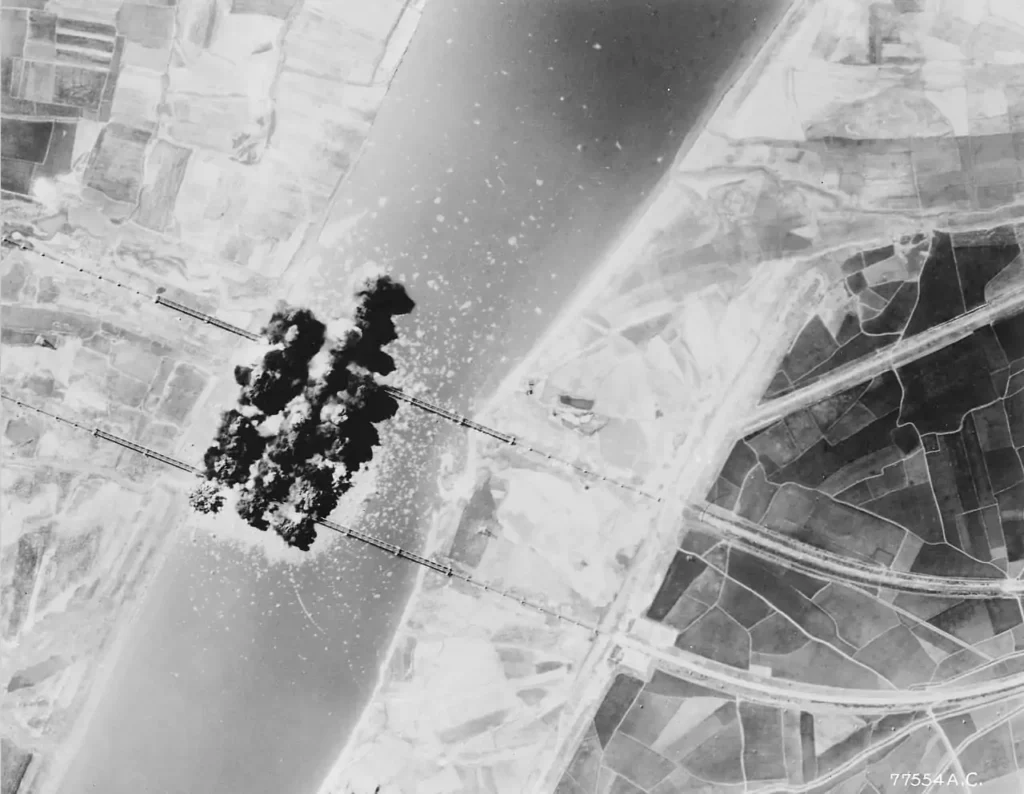
- July 6
The first strategic air attacks of the conflict saw nine B-29s bombing the Rising Sun oil refinery in Wonsan and a chemical factory in Hungnam, both located in North Korea. - July 8
The Far East Air Forces (FEAF) Bomber Command was established within the FEAF and was led by Major General Emmet O’Donnell. - July 9
The 92nd Bomb Group of the Strategic Air Command (SAC) arrived at Yokota to commence combat operations in Korea.

- July 11
Eight B-29s from the 19th Bomb Group were assigned to carry out a tactical strike and successfully established radio contact with ground units. They targeted North Korean units in Wonju, Pyongtaek, and Chunchon, achieving favorable results. - July 12
- The 92nd Bomb Group’s first mission saw the group, operating from its base at Yokota, Japan, bombing the marshaling yards in Seoul.
- The first B-29 (44-69866) was lost to enemy action on July 12. The aircraft was part of the 28th Bomb Squadron of the 19th Bomb Group. A North Korean Yakovlev Yak-9 fighter briefly appeared behind the bomber and damaged its number three engine, causing a fire that could not be contained. The plane crashed into the Yellow Sea, west of Seoul. The bombardier was forced to bail out over enemy territory and became the first prisoner of war (POW) in the conflict. The majority of the crew was rescued and returned to Japan within 24 hours.
- July 13
- The Far East Air Forces (FEAF) Bomber Command dispatched 49 B-29s from the 22nd and 92nd Bomb Groups to bomb the marshaling yards and an oil refinery in Wonsan, North Korea. This marked the first Korean combat mission for the Strategic Air Command’s (SAC) 22nd Bomb Group.
- B-29 lost: A B-29 from the 92nd Bomb Group, 325th Bomb Squadron, named “Hoxie’s Hoax” (44-61923) was lost during a bombing mission. The bomber lost an engine while en route and started to return to base. To maintain altitude, the crew jettisoned the bomb load over the water, but one 500 lb bomb detonated underneath the aircraft. The B-29 crashed into the Sea of Japan near Dogo Island. Five crew members were rescued.
- The 3rd Air Rescue Squadron (ARS) began operating SB-17 aircraft along the coast of Korea to deploy rescue boats for B-29 crew members who had gone down.
- July 16
During a raid, thirty B-29s targeted the railway yards in Seoul and finally succeeded in destroying the railway bridge that spanned the Han River, despite it having been left unscathed in several previous air raids. - July 17
Forty-seven B-29s targeted the Chosin Nitrogen Plant in Hungnam along the northeast coast of North Korea. Unfortunately, a group of 3 B-29s mistakenly bombed friendly civilians in Andong. - July 18
The 19th Bomb Group made alterations to certain B-29 aircraft so that they could utilize radio-guided bombs (Razon) to make their bridge bombing more precise.
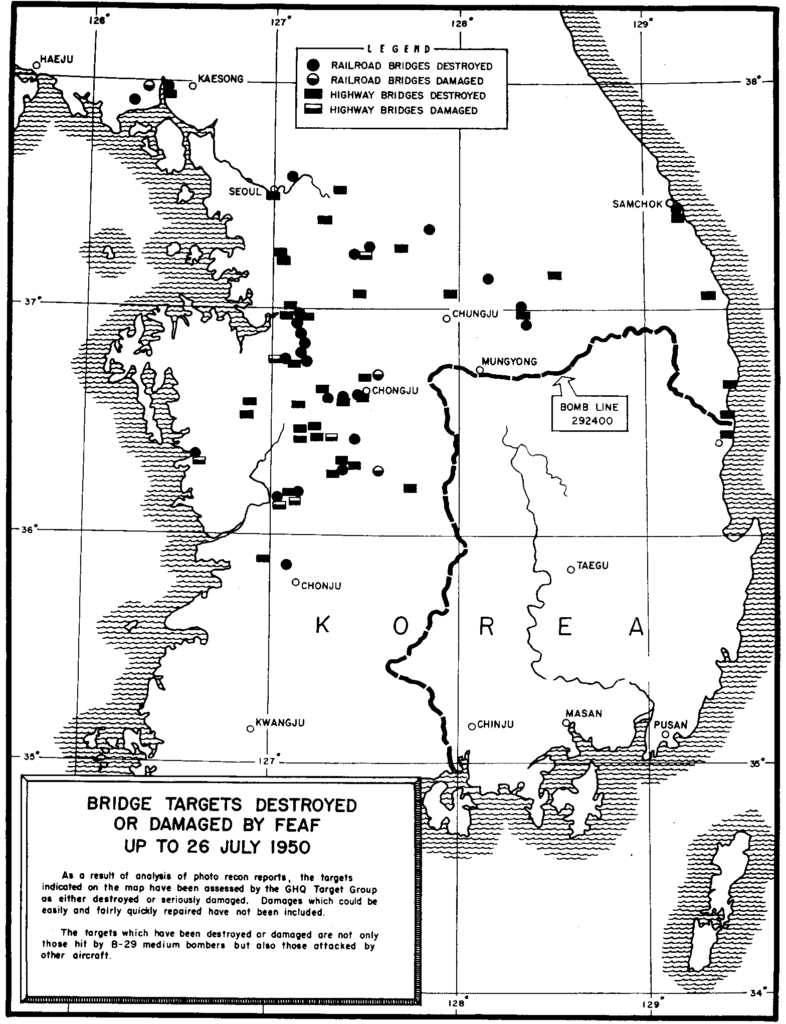
- July 29
The B-29 Superfortresses conducted intense bombing attacks on key strategic targets north of the 38th Parallel and initiated heavy bombing campaigns aimed at clearing the enemy-occupied mountain ridges and hills from which enemy ground forces were launching attacks against American troops. - July 30
Forty-seven B-29 Superfortresses carried out an attack on the Chosin Nitrogen Explosives Factory located in Hungnam on the eastern coast of North Korea.
August 1950
The US Air Force relocated two more B-29 groups from the US to the Far East, increasing their presence to a total of five groups. During the month of August, the B-29 Superfortresses launched bombing missions against marshaling yards and industrial sites in North Korea, as well as port facilities and bridges in both North and South Korea, with a particular emphasis on those in the vicinity of Seoul. Additionally, they carried out a massive carpet-bombing raid close to the front line.
- August 1
- The initial components of the 307th Bombardment Group from SAC were deployed from MacDill Air Force Base in Florida to Kadena Air Base in Okinawa.
- Forty-six B-29 Superfortresses from the 22nd and 92nd Bomb Groups targeted the Chosin Nitrogen Fertilizer Factory located at Hungnam, the largest chemical plant in the Far East.
- August 4
- Permission was granted for B-29s to bomb strategic targets in North Korea.
- The initiation of FEAF’s “Interdiction Campaign No. 1” was marked by B-29 attacks on crucial bridges located north of the 38th parallel.
- August 5
The initial contingent of the 98th Bombardment Group from SAC arrived at Yokota Air Base in Japan, ready to commence combat operations in Korea. - August 6
The B-29s released M-26 parachute flares, left over from World War II, over suspected enemy routes from a height of about 10,000 feet. B-26s followed, observing the flares as they exploded at around 6,000 feet and struck any targets that were discovered. Unfortunately, many of the old flares were not functioning properly. - August 7
The 98th Bombardment Group conducted its initial sortie in the Korean War soon after twenty of its B-29 aircraft arrived at Yokota Airbase in Japan. The mission targeted the city of P’yongyang, resulting in substantial destruction to the rail yards and nearly total obliteration of an arsenal. The bombing raids also targeted the Chosin Petroleum complex located in the port town of Wonsan, which was responsible for producing over 90% of North Korea’s petroleum products. The bombing runs on the 9th and 10th of the campaign effectively wiped out the entire facility.
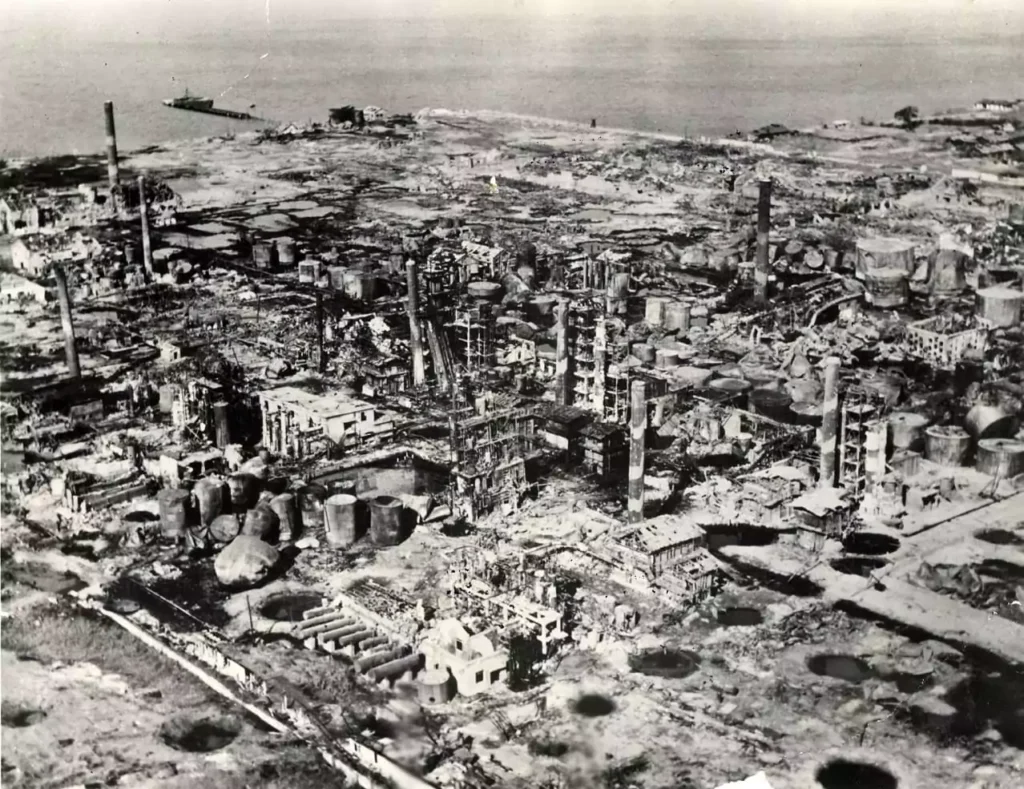
- August 8
The 307th Bombardment Group carries out its initial mission during the Korean Conflict. - August 10
Forty-six B-29s of the 22d, 92d, and 98th Bomb Groups hit an oil refinery and the railroad shops at Wonsan, North Korea. - August 11
B-29 lost: When returning to Kadena AFB, Okinawa, a B-29 (42-93903) from the 19th Bomb Group was unable to lower the undercarriage. Following many tests, the crew made the decision to depart Kadena and flew over the East China Sea to ditch the plane. Everyone was rescued. - August 12
More than forty B-29s attacked the port of Rashin in northeastern Korea, near the border with the Soviet Union. - August 16
Ninety-eight B-29s carpet-bombed suspected enemy troop concentrations in a 27-square-mile area near Waegwan northwest of Taegu. The Superfortresses dropped more than 800 tons of 500-pound bombs in the largest employment of air power in direct support of ground forces since the Normandy invasion of World War II. Subsequent reconnaissance showed little destruction of enemy troops or equipment because they had already left the area. - August 19
- A total of 46 B-29 Superfortresses from the 22nd, 92nd, and 98th Bombardment Groups targeted an oil refinery and railroad workshops in Wonsan, North Korea.
- The 19th Bomb Group launched an air assault, sending nine B-29 Superfortresses to drop 54 tons of 1,000-pound bombs on the west railway bridge at Seoul. The bridge, known for its resilience in previous air raids, was finally brought down by the combined efforts of the USAF and 37 USN dive bombers from two aircraft carriers. An aerial reconnaissance the following day revealed that two spans of the bridge had collapsed.
- August 22
The first instance of hostility from the Chinese against UN aircraft took place when antiaircraft gunners across the Yalu River fired at RB-29s conducting reconnaissance along the border. - August 27
The 92nd Bomb Group dispatched 24 B-29s to Kyomipo to strike the biggest iron and steel factory in Korea. The Far East Air Force conducted trials with bombs that had a delayed-action mechanism in order to impede the enemy from repairing bridges. - August 28
B-29 bombers conducted heavy bombing raids on Songjin, a key industrial center in North Korea known for its metalworking factories. - August 30
Before sunrise, an experimental mission utilizing B-29 flares lit up the Han River near Seoul to assist a B-26 attack on a pontoon bridge used by the enemy, however, it could not be located. The B-26s then targeted the permanent bridge instead. - August 31
Seventy-four B-29s conducted a massive strategic bombing operation, targeting the mining facilities, metal works, and rail yards at Chinnampo. The attack aimed at destroying aluminum and magnesium plants, among other targets, and was the most significant bombing mission of the month.
September 1950
The FEAF’s operations in Korea reached a peak during September, with Bomber Command carrying out a major B-29 bombing campaign targeting industrial facilities and troop training centers in cities like Wonsan, Hungnam, Hamhung, Pyongyang, Songjin, and Chongjin in North Korea. Additionally, B-29s conducted bombing missions on marshaling yards and railroad junctions in North Korea and provided close air support to the Eighth Army in South Korea.
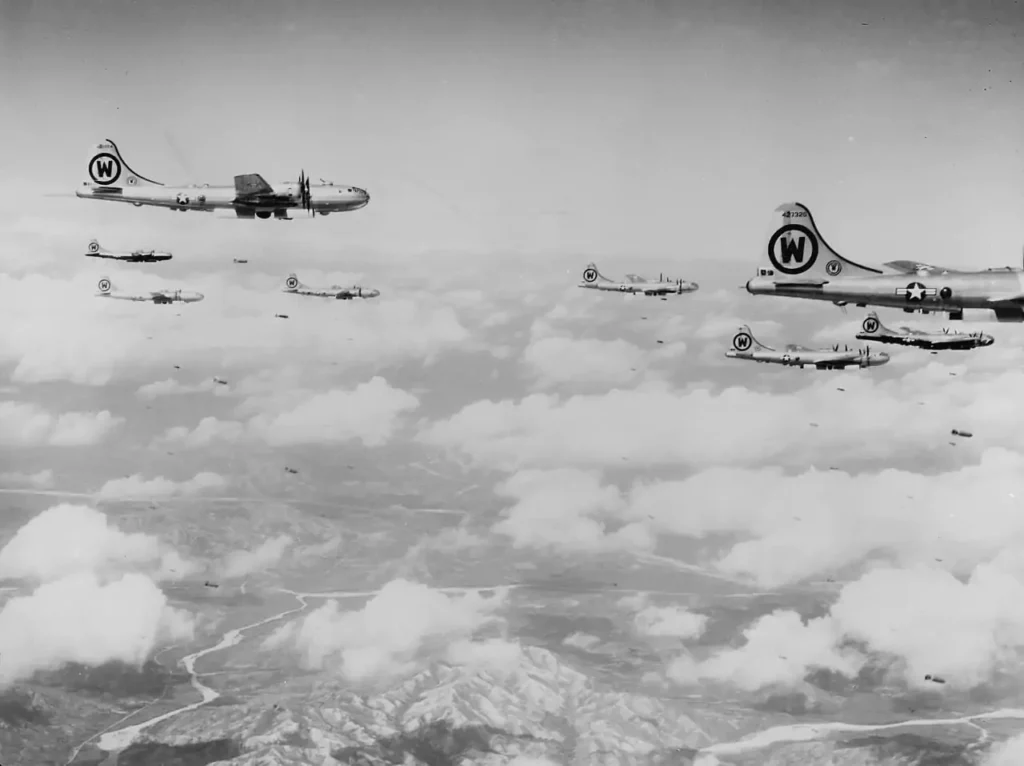
- September 1
General MacArthur instructed General Stratemeyer to employ all the air power available through FEAF, including B-29s, to support the Eighth Army in maintaining control over the “Pusan Perimeter,” the portion of the Korean peninsula located in the southeast that was still under the control of South Korea.
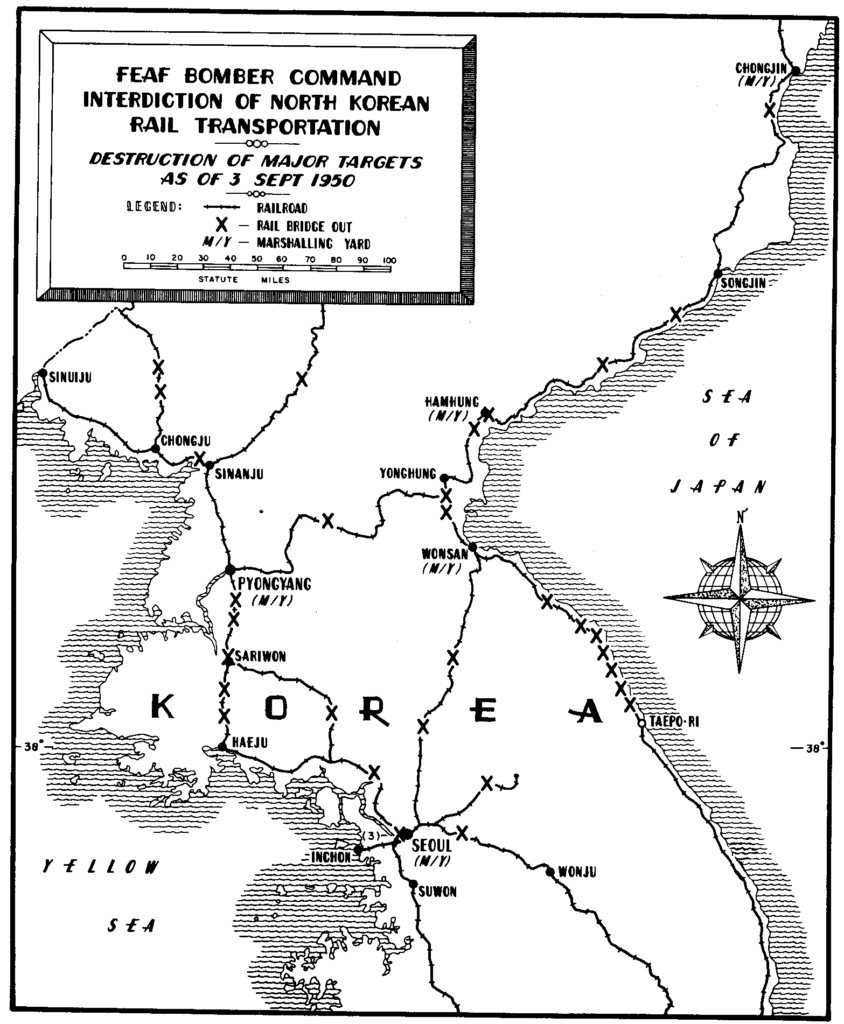
- September 7
The 22nd Bomb Group used 24 B-29s to carry out a bombing mission on the ironworks in Chongjin, located in the far northeast of North Korea, under the direction of FEAF Bomber Command. - September 8
- B-29 lost: Eight crew members lost their lives when B-29 42-94072 from the 307th Bomb Group and 371st Bomb Squadron crashed into the East China Sea, five miles north of Okinawa, during its return from a bombing mission over Korea.
- September 9
- FEAF Bomber Command initiated a campaign aimed at disrupting the enemy’s rail reinforcements north of Seoul to counteract the potential counterattack against the UN landing at Inchon. In this effort, the medium bombers carried out simultaneous assaults on marshaling yards and targeted cuts to the rails at various points along crucial routes.
- B-29 lost: B-29 Superfortress 44-62084 from the 92nd Bomb Group’s 325th Bomb Squadron was hit by enemy anti-aircraft fire near Wolbong-ni and exploded in mid-air.
- FEAF Bomber Command initiated a campaign aimed at disrupting the enemy’s rail reinforcements north of Seoul to counteract the potential counterattack against the UN landing at Inchon. In this effort, the medium bombers carried out simultaneous assaults on marshaling yards and targeted cuts to the rails at various points along crucial routes.
- September 15
B-29 lost: B-29 44-86328 from the 19th Bomb Group’s 28th Bomb Squadron crashed into the China Sea during takeoff from the Kadena airstrip, resulting in a ditching. - September 16
The Air Force was forced to call off a planned carpet bombing of the enemy positions at Waegwan by B-29s due to dark clouds, fog, and heavy rainfall. - September 18
Forty-two B-29s of the 92d and 98th Bomb Groups conducted saturation bombing on two 500-by-5,000-yard areas near Waegwan. The 1,600 bombs were effective in wiping out enemy troops’ concentrations, thereby clearing a path for the Eighth Army’s offensive. - September 22
At night, B-29s illuminated rail lines with flares, enabling B-26s to launch strikes against enemy trains. - September 26
Twenty aircraft from the 22d Bomb Group carried out an attack on a munitions factory in Haeju, effectively destroying its power plant and five adjacent buildings. Meanwhile, B-29s from the 92d Bomb Group targeted the Pujon hydroelectric plant near Hungnam, bringing the first phase of the strategic bombing campaign against North Korea to a close.
October 1950
Due to the limited availability of strategic targets in North Korea, the 22nd and 92nd Bomb Groups were able to bring their B-29s back to the United States. The Far East Air Force’s (FEAF) mission to damage bridges south of the Yalu River came to a close, and as the frequency of fighter and bomber missions decreased, the number of cargo flights increased. Throughout the month, FEAF aircraft disseminated General MacArthur’s surrender demand by dropping 4,440,000 leaflets in regions of North Korea that were still not under the United Nations’ control.
- October 2
Twenty-two B-29s from the FEAF Bomber Command targeted a North Korean military training facility in Nanam with the aim of crippling NKA reinforcements. The bombing resulted in the destruction of three-quarters of the buildings at the site.
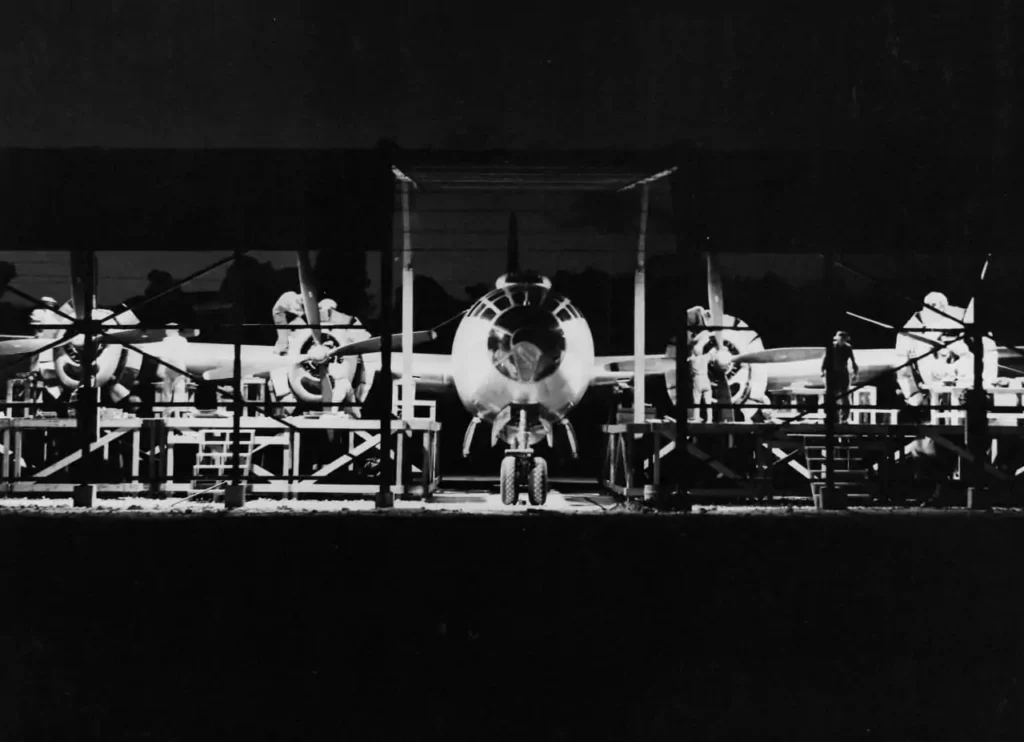
- October 5
B-29 lost: After departing from Ashiya AB in Kyushu, Japan, and making its way towards the Korean peninsula, 42-65353 of the 98th Bomb Group faced an engine fire. The crew quickly took action and bailed out, with all members being safely rescued. The aircraft ultimately crashed into the waters about 10 miles (16 km) west of Wakamatsu Island.
- October 6
- Eighteen B-29s from the FEAF Bomber Command targeted a North Korean arsenal located at Kan-ni.
- The FEAF revised its interdiction plan and discontinued its bombing campaigns against bridges south of the cities of Pyongyang and Wonsan.
- October 18
The crew of an RB-29 reconnaissance plane discovered the presence of over seventy-five fighter aircraft at Antung’s airfield, located on the Chinese side of the Yalu River and near North Korea, indicating a potential intervention by Communist China in the conflict. - October 19
B-29 lost: The bomber, 44-62279, belonging to the 33rd Bomb Squadron of the 22nd Bomb Group, took off from Kadena AFB on Okinawa and was en route to the battle zone. As it was gaining altitude, the aircraft encountered difficulties with its first engine and had to return to Kadena AB for a landing. To lighten the load, the crew jettisoned some of the bombs, but a number of them exploded upon hitting the water. The bomb fragments caused significant damage to the aircraft, breaking its control cables, and forcing the crew to ditch into the sea approximately five miles away from the end of the runway. Tragically, eight crew members lost their lives, while three others were injured. - October 25
The FEAF Bomber Command was forced to temporarily halt its combat missions due to a shortage of viable targets in Korea that could be attacked by B-29s.
- October 26
B-29 lost: The B-29 Nipp-on-Nees from the 92nd Bomb Group 327th Squadron (44-61617) was lost for reasons unknown. - October 28
The 22nd Bomb Group returned to the United States after successfully completing 335 combat missions over a period of four months. During these missions, only 14 had to be aborted, and the group dropped a total of more than 6,500 tons of bombs. - October 29
The 92nd Bomb Group returned to the United States after the completion of its deployment.
November 1950
Despite UN forces taking control of much of North Korea, the Superfortresses’ bombing of enemy ports and bridges along the Yalu River was ineffective in halting the influx of Chinese troops. Even if the FEAF bombers managed to demolish all of the permanent bridges across the Yalu, the Chinese could have used pontoon bridges or crossed where the river was frozen over. Since they couldn’t fly over Manchuria, the B-29s targeted the bridges by following the river’s route. Escort fighters could only fly on the Korean side of the bombers, making the Superfortresses vulnerable to enemy fighters and antiaircraft guns stationed in China. This resulted in FEAF limiting the flights in the area.
The B-29s of the FEAF Bomber Command dropped incendiary bombs on enemy ports, as well as on supply and communication centers close to China. In accordance with General MacArthur’s orders, the command launched a two-week incendiary bombing campaign in early November targeting North Korean cities and towns in order to destroy enemy supplies and shelter for troops.
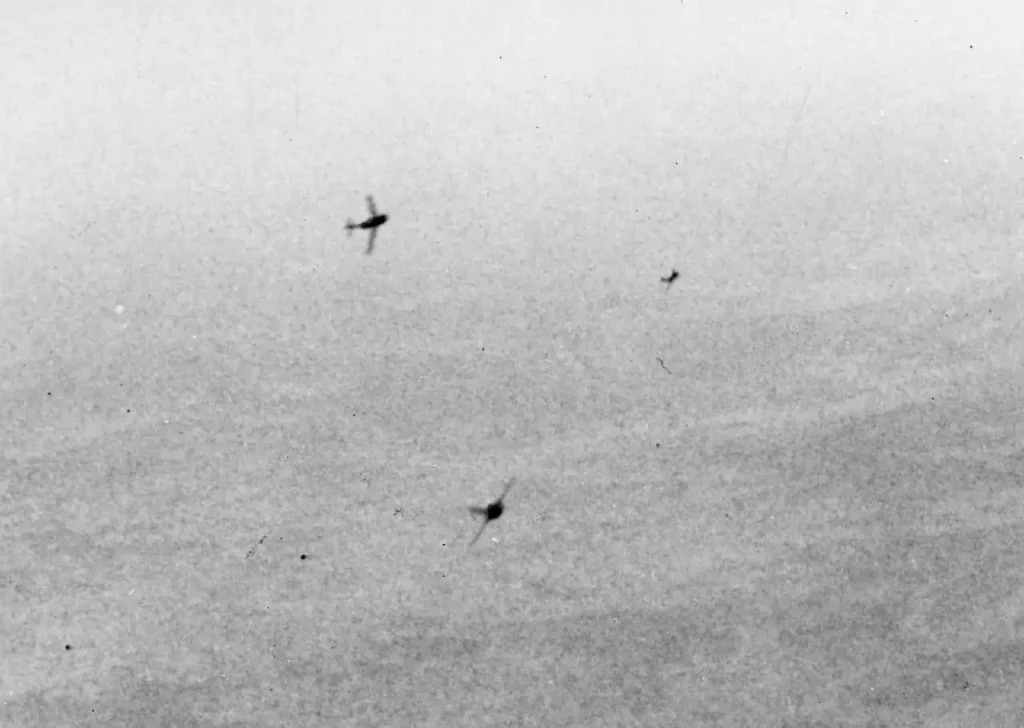
- November 1
MIG-15s appear over North Korea. - November 5
The 19th Bomb Group initiated its campaign of incendiary bombing on North Korean cities and towns, starting with Kanggye. 21 B-29s dropped a total of 170 tons of fire bombs on the town, located just 20 miles away from the Chinese border. The bombing resulted in the destruction of 65% of Kanggye’s central area. - November 8
The largest bombing raid of the Korean War saw seventy B-29 Superfortresses dropping approximately 580 tons of incendiary bombs on Sinuiju, located close to the Chinese border. This was also the first time that B-29s attacked bridges across the Yalu River. - November 9
B-29 lost on the first B-29 to encounter MIG: The RB-29A named “Over Exposed”, with the serial number 44-61813 and belonging to the 91st Strategic Reconnaissance Squadron of the US Air Force, was sent to the Sinuiju area to assess the impact of a raid carried out by naval forces. The aircraft was accompanied by 8 F-80 Shooting Stars. Upon reaching the target, two MiG-15s from the 72nd Guards Fighter Air Regiment piloted by Major Bordun and Senior Lieutenant Dymchenko, engaged the RB-29 in an attack. The two pilots made two passes at the RB-29, causing it to catch fire and quickly descend toward territory controlled by the United Nations. Tragically, five crew members lost their lives when the RB-29 crash-landed during an emergency landing at Johnson Air Base in Japan. - Editor note: Cpl. Harry J. LaVene, the tail gunner of 44-61813, is credited with the first B-29 jet victory of the Korean War, destroying an attacking MiG-15. However, no casualties were reported from the Soviet side.
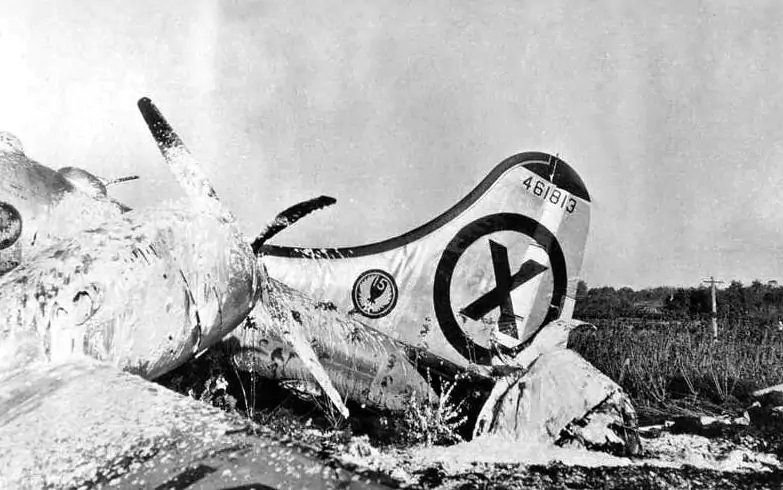
- November 10
MiG-15s near the Yalu River shot down a B-29 for the first time.
A formation of seven B-29s from the 307th Bomb Group was targeted by MiGs from the 28th Fighter Air Division. Major Kharkovskiy and Lieutenant Akimov received credit for bringing down one B-29 each. The US confirmed that a bomber from the 307th Bomb Group was lost, with B-29 45-21814 from the 371st Bomb Squadron being shot down seven miles southwest of Kusong. The crew was forced to bail out and became POWs behind enemy lines. - November 12
On a mission to counter a raid on the Yalu River railway bridge, 32 fighters from the 151st and 28th Fighter Air Divisions took to the skies. The MiGs engaged in combat with the F-80 escort fighters while the B-29s targeted the bridge. Despite no reported victories for the MiG pilots that day, the United States Air Force reported that a B-29 from the 98th Bomb Group was damaged by the MiGs on November 12th and barely made it back to Kimpo, where it had to make an emergency landing. - November 13
A formation of nine B-29 bombers targeted the bridges in Sinuiju, while eight MiGs from the 72nd Guards Fighter Air Regiment were dispatched to counter the raid. However, they were unable to reach the B-29s as they encountered strong resistance from the escort fighters and ran out of time.
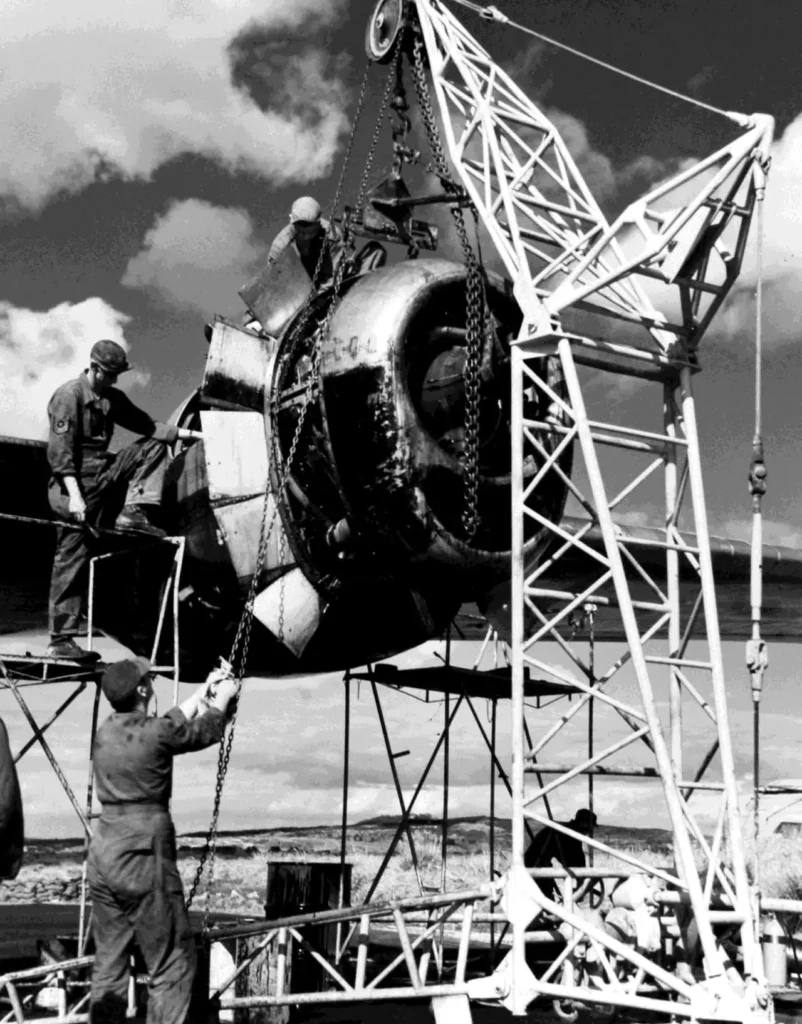
- November 14
Major Kharkovskiy led fifteen MiG-15s from the 28th Fighter Air Division in an attack against eighteen B-29s that were bombing bridges in Sinuiju. The raid resulted in two B-29s suffering serious damage, one of which was the 98th Bomb Group’s 44-61676, which was forced to crash-land at Kimpo, Seoul during an emergency landing. In the battle, Staff Sergeant Richard W. Fisher was recognized for downing one of the attacking MiGs, marking the last engagement between the Superfortresses and MiGs that month.
- November 15
B-29 lost: A B-29 bomber from the 93rd Bomb Squadron of the 19th Bomb Group, sn 44-62152, suffered a crash while attempting to take off from Kadena Air Force Base. The aircraft was deemed irreparable due to the extent of the damage and was written off. Despite the crew sustaining injuries, all members were safely rescued. - November 24
In support of the United Nations’ offensive starting on this day, the B-29s targeted North Korean supply and communication hubs and bridges across the Yalu River. - November 26
The B-29 bombers from the 19th and 307th Bombardment Groups targeted and successfully demolished two bridges spanning the Yalu River near Manpo and Ch’ongch’on.
December 1950
Bomber Command regularly carried out B-29 bombing raids on North Korean cities that functioned as supply or communication hubs for the enemy, including Sinanju, Anju, Kanggye, Pyongyang, and Wonsan.
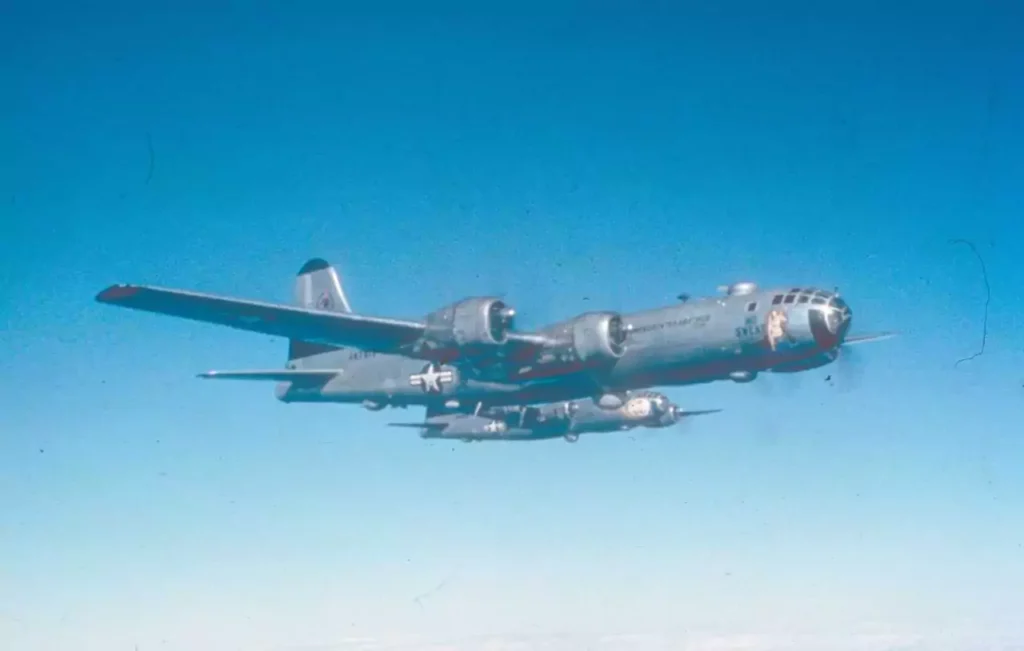
- December 1
During the first extended engagement between MiGs and B-29s in the conflict, a group of six MiG-15s, led by Senior Lieutenant Orlov from the 29th Guards Fighter Air Regiment of the 50th Fighter Air Division, took on three B-29s in a six-minute-long encounter. Despite the presence of F-80 escorts, the MiGs were able to inflict significant damage on the bombers. - December 6
The MiGs from the 29th Guards Fighter Air Regiment participated in another encounter with B-29s and three pilots were credited with successful shots. Lieutenant N.N. Serikov was claimed to have been brought down by the B-29s. On the other hand, the US did not report any losses on that day. - December 7
The Far East Air Force’s B-29 bombers carried out air raids on North Korean towns near the Changjin Reservoir region in support of U.S. Marine Corps and Army units trying to escape from Hagaru-ri and Koto-ri. - December 13
B-29 lost: The B-29 aircraft with serial number 44-61749, named Southern Comfort and belonging to the 19th Bomb Group 30th Bomb Squadron, made a forced landing on November 7th, 1950 at Itazuke Air Base in Fukuoka, Japan, as a result of a fire in flight. Two crew members sustained injuries, and the aircraft was salvaged at the airbase. The loss was categorized as operational and not caused by enemy action. - December 18
- B-29 lost: B-29 with serial number 44-86330 from the 98th Bomb Group 343rd Bomb Squadron, nicknamed “Ape Ship”, was shot down. Its tail code was Square H and the location of the crash is unknown.
- B-29 lost: Superfortress with serial number 44-62111, belonging to the 92nd Bomb Group and without a name, was identified by its tail code symbol, Circle. It was surveyed at Yokota AFB for an undisclosed reason.
- December 31
Sixty-nine B-29 Superfortresses delivered incendiary bombs over Pyongyang.
January 1951
The Far East Air Force (FEAF) Bomber Command carried out attacks on North Korean military facilities, airfields, and supply depots, flying over 720 sorties and dropping more than 6,700 tons of bombs. Despite the potential danger posed by the large number of MiG-15s in the northwestern region of Korea, the Superfortresses mainly targeted bridges with radio-guided bombs. The main focus of the air campaign was to destroy key North Korean cities, with large formations of B-29s bombing Pyongyang, the capital, using incendiary bombs. Other cities that were targeted in major incendiary raids were Hamhung, Kaesong, and Komusan. By the end of the month, the FEAF Bomber Command, consisting of about 100 B-29s, was conducting daily missions with about 24 Superfortresses from the 19th, 98th, and 307th Bomb Groups. The command also began night harassment attacks on North Korean cities in January.
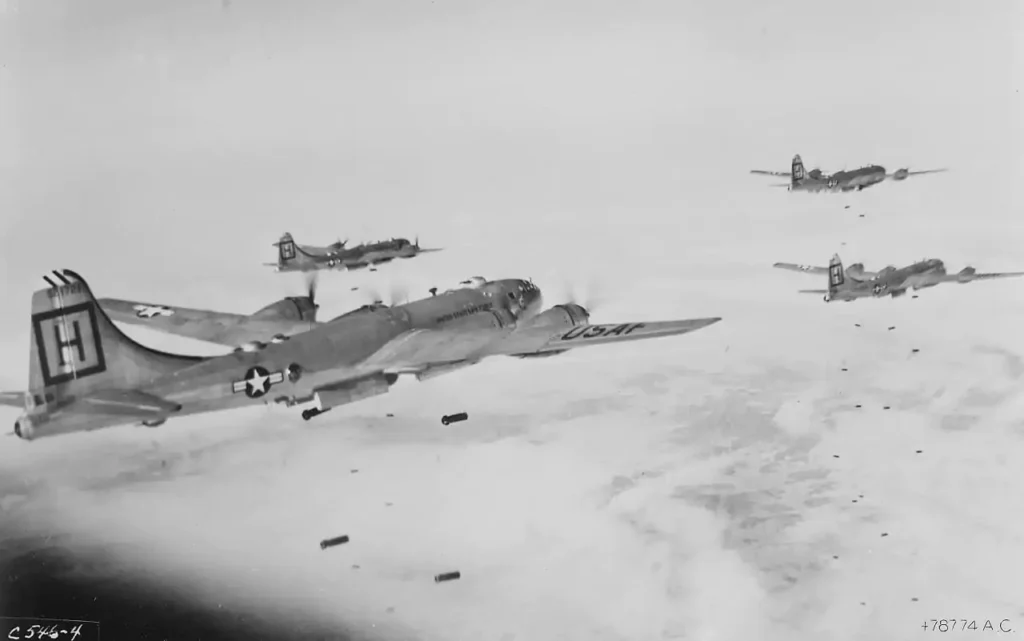
- January 3
One of the largest bombing raids conducted by the FEAF Bomber Command involved over 60 B-29 bombers that dropped a total of 650 tons of incendiary bombs on the city of Pyongyang. - January 5
On a bombing mission, fifty-nine B-29s rained down 672 tons of incendiary bombs on the North Korean capital city of Pyongyang. - January 8
B-29 Superfortresses bombarded Kimpo Airfield, effectively rendering it unusable for enemy aircraft.
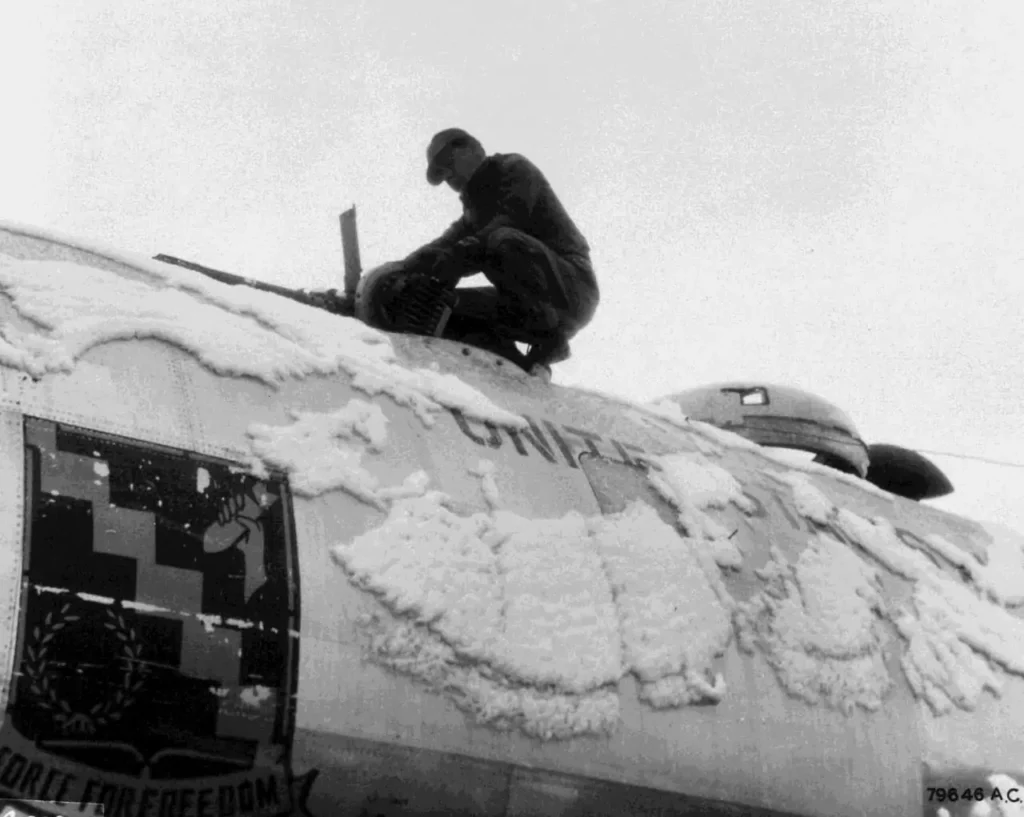
- January 12
After the city of Wonju was captured by communist forces, the 98th Bomb Group dispatched ten B-29 bombers to strike the occupied location. During this mission, the B-29s utilized a new tactic by dropping 500-pound general-purpose bombs that were set to explode in the air, releasing thousands of steel fragments to shower the enemy troops below. This innovation was successful in slowing down the enemy’s advancement.
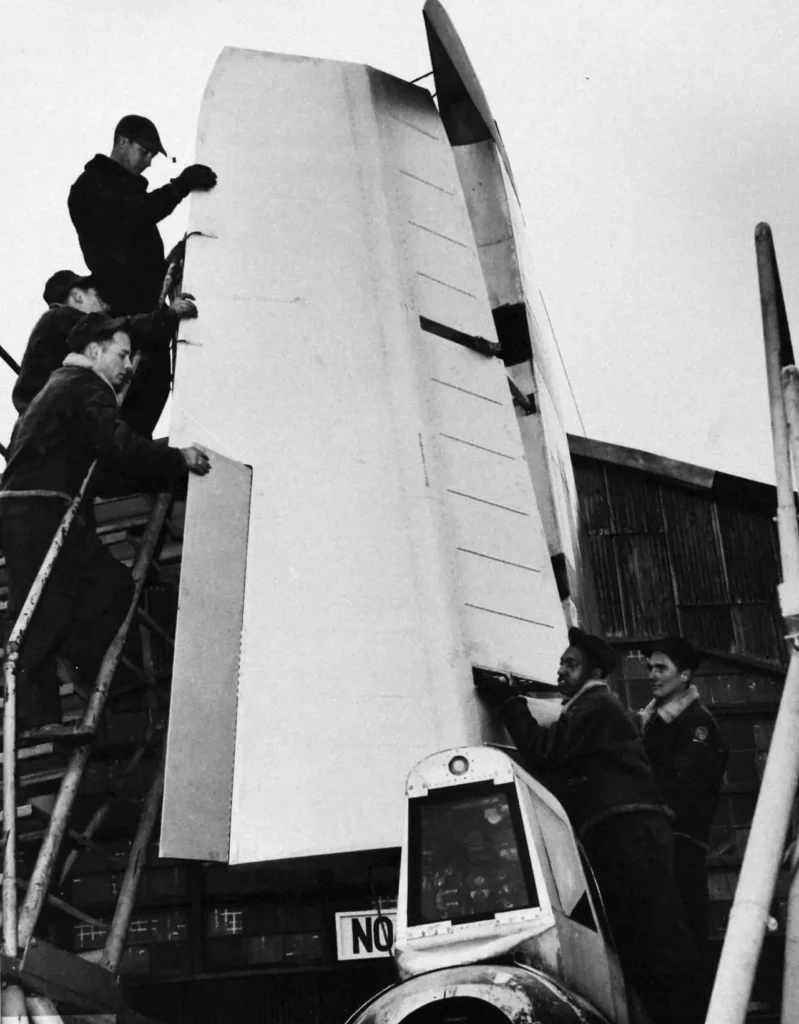
- January 19
The FEAF initiated a 13-day intensive air campaign with fighters, light bombers, and medium bombers to severely limit the supplies and reinforcements reaching enemy forces in the field. - January 23
As forty-six F-80 fighter aircraft suppressed antiaircraft artillery in Pyongyang, twenty-one B-29 bombers struck the airfields in the enemy capital, creating craters.
February 1951
To mitigate the risk of MiG encounters, Fifth Air Force shifted the focus of its operations to the Yalu River region, where it conducted interdiction missions with its B-29s. This change allowed FEAF Bomber Command to reassign its B-29s to psychological warfare missions, using C-47 aircraft from the 315th AD to drop 25 million leaflets over North Korean cities, urging the enemy to lay down their arms.

The focus of the Superfortresses was on interdiction targets outside the MiG Alley region, particularly on railroad bridges. Additionally, they bombarded airfields, rail lines, and barracks situated in western North Korea between Kanggye, Sinanju, and Pyongyang. Throughout the month, FEAF Bomber Command continued to launch nighttime harassment raids against cities such as Anju, Sinanju, Sariwon, and Pyongyang, with two to six bombers sent out on each mission after February 10th. During this month, the Bomber Command conducted 687 sorties in Korea, releasing a total of 6,213 tons of bombs.

- February 8
FEAF launched a comprehensive offensive against rail lines in northeastern Korea, utilizing B-29s, B-26s, and fighter aircraft, targeting the region between Hoeryong and Wonsan. - February 10
The 307th Bomb Group transfers control of its tactical operations to the 307th Bombardment Wing.
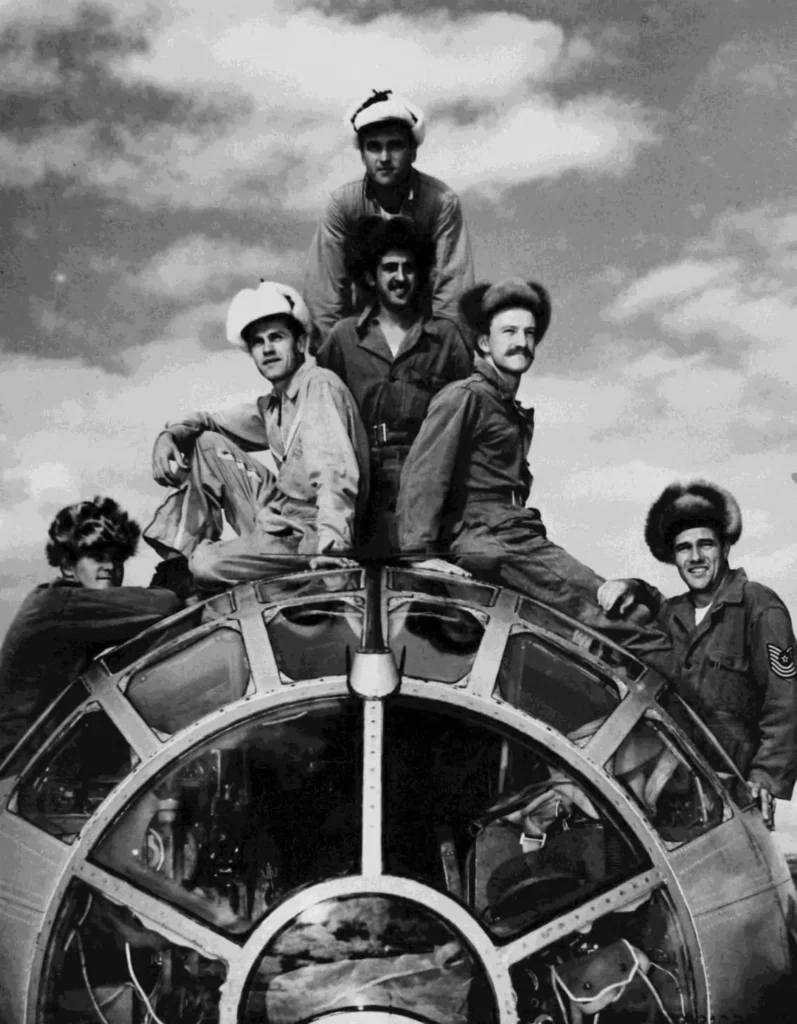
- February 23
The first bombing mission using the advanced MPQ-2 radar was carried out by FEAF Bomber Command’s B-29s, targeting a bridge on a highway located seven miles northeast of Seoul.
March 1951
The FEAF Bomber Command continued to conduct bombing missions in North Korea, rotating among three groups. To defend the B-29 Superfortresses, Fifth Air Force deployed F-86 fighter jets from Taegu and Suwon during their interdiction missions. This led to an increase in air-to-air combat, particularly in the Sinuiju and Sinanju regions of northwest Korea. During March, B-29 gunners were credited with three out of five aerial victories. The FEAF Bomber Command executed nearly 800 sorties, with a focus on interdiction targets, and dropped a total of 6,372 tons of bombs. Many of these sorties lasted for over nine hours.
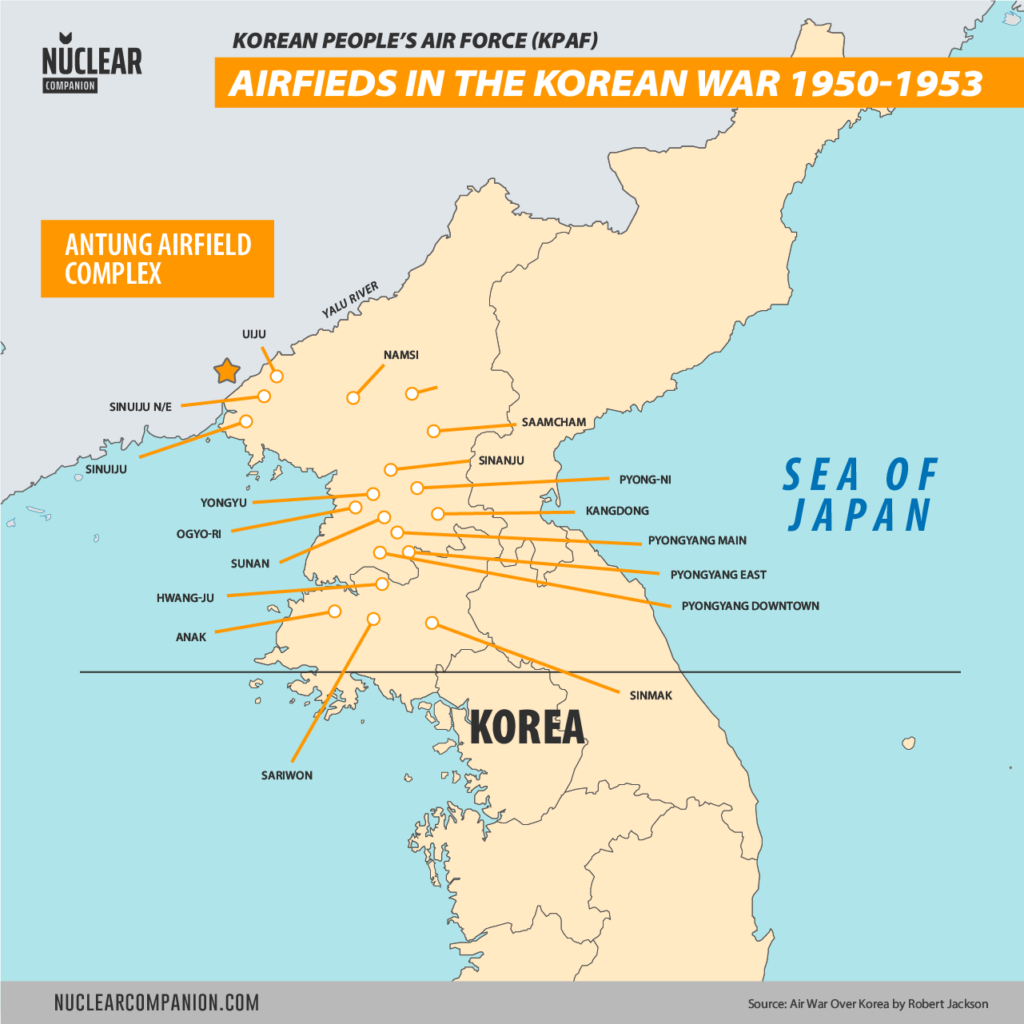
- March 1
The first mission of a new interdiction campaign was carried out by FEAF Bomber Command B-29s. Twenty-two F-80s were dispatched to escort the eighteen B-29s over Kogunyong, North Korea, but had to return to base due to low fuel levels and were unable to provide protection for the Superfortresses. Despite the lack of escort, the B-29s were targeted by MiGs, with ten of them suffering damage. Three of the damaged B-29s were forced to make an emergency landing in South Korea, but a B-29 gunner was able to successfully shoot down a MiG. - March 19
- A group of B-29s, part of the 343rd Bombardment Squadron and 98th Bombardment Group, encountered MiG-15s near Sonchin. During the encounter, a tail gunner, Sergeant William H. Finnegan, successfully shot down one of the attacking MiG-15s.
- B-29 lost: The B-29 bomber with serial number 45-21749, attached to the 93rd Bombardment Squadron of the 19th Bombardment Group, crashed into the China Sea after two engines failed following an apparent explosion caused by a Tarzon bomb salvo. The Group Commander, Colonel Payne Jennings, was on board. Two other planes from the 19th Bombardment Group were also modified to carry the 12,000-pound Tarzon bomb – 45-21745 “Lucifer” and 45-21746. The former was surveyed on February 14, 1952, while the latter survived the war.
- March 20
The Far East received fifteen F-94B all-weather jet fighters, which were destined to serve as night escorts for B-29s. - March 23
Twenty-two B-29 bombers from the 19th Bomb Group and 307th Bomb Wing, with protection from 45 F-86 fighters, successfully took down two bridges in the northwest region of Korea. - March 29
B-29 bombers, accompanied by fighter escorts, made a comeback to the Yalu River region with the aim of bombing the bridges that had regained significance as the ice on the river began to melt. - March 30
For the first time, two MiGs were shot down in a single day by B-29 gunners, SSgt. Norman S. Greene and TSgt. Charles W. Summers of the 28th Bombardment Squadron (BS).
April 1951
Due to the enemy’s efforts to build new airfields and repair damaged ones in North Korea, the likelihood of a significant air-ground offensive by the enemy increased. To combat this, General Stratemeyer, the Commander of FEAF, instructed the majority of the B-29s to focus their bombing efforts on these airfields in North Korea.
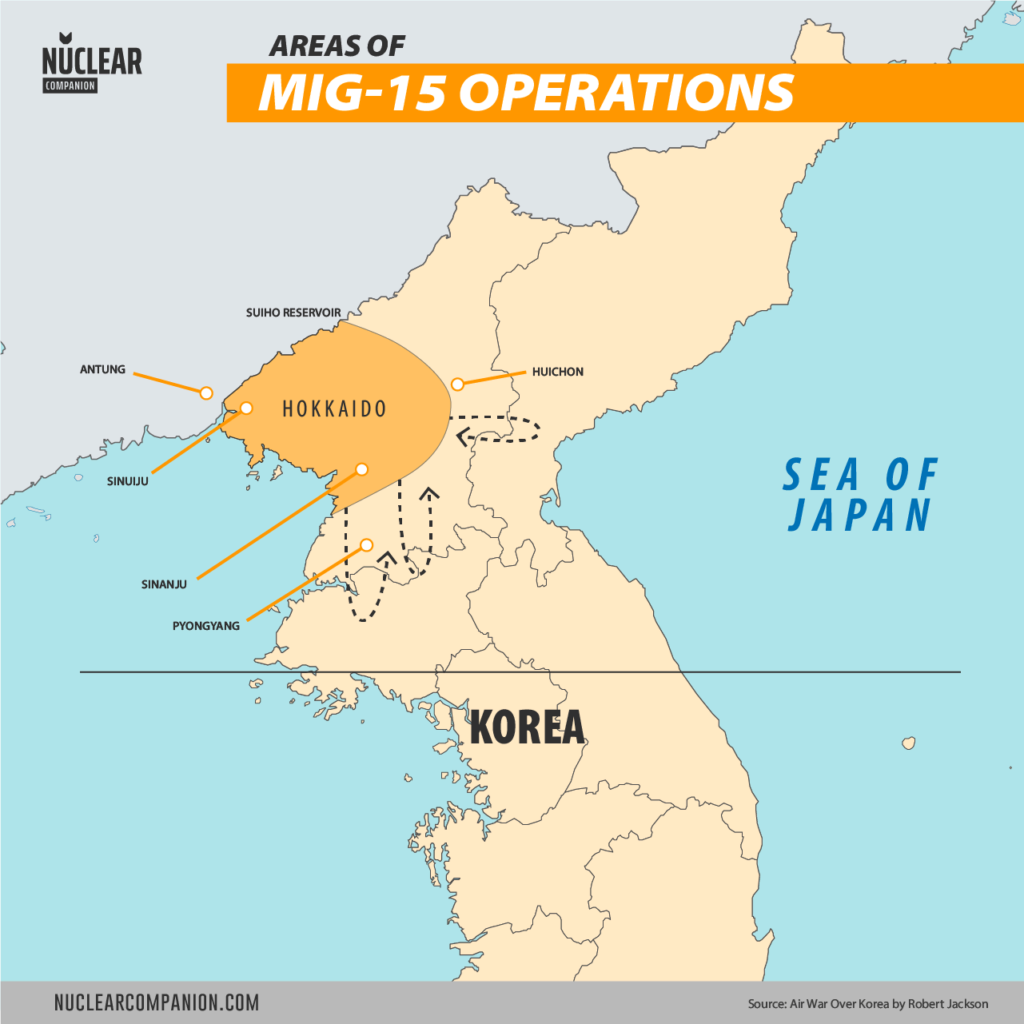
- April 1
The 98th Bombardment Wing took over the tactical operations of the 98th Bomb Group. - April 6
- B-29 lost: The B-29, with serial number 45-21725, from the 307th Bomb Wing 370th Bomb Squadron and without a name, crash landed at Naha Air Base, Okinawa, on March 29th due to unfavorable weather conditions. A crew member sustained injury and the aircraft was deemed beyond repair after being surveyed on the same date. Surveyed this date.
- B-29 lost: Black Sheep, a B-29 bomber with serial number 42-65369 and assigned to the 19th Bomb Group/93rd Bomb Squadron, crashed and burned off the runway at Kadena, Okinawa. During touchdown, one of the main landing gear failed, causing the aircraft to go out of control and come to rest in flames. All 14 crew members were rescued, but some sustained injuries. The aircraft was destroyed by the fire.
- April 7
B-29 lost: 48 F-84Es took off from Japan to join forces with the B-29 bombers en route to the heavily guarded MiG Alley. The bombers launched air raids on Sinuiju and Uiju, guarded by the 27th Fighter Escort Wing. However, MiG fighter jets attempted to intercept them, with one of the 30 planes breaking through the defense to attack the bombers. Tragically, one B-29 was shot down during the battle, the aircraft, serial number 44-86268, was from the 307th Bombardment Wing 371st Bombardment Squadron. The aircraft sustained damage from the MiGs on this date and was surveyed on May 14th, 1951. - April 10
B-29 lost: On a night intruder mission over Sinanju, North Korea, the B-29 with serial number 44-62108 from the 98th Bomb Wing 343rd Bomb Squadron was hit by enemy fire. The crew managed to safely evacuate the area and return to Daegu Airport, however, with two engines not functioning properly, the aircraft crashed upon landing and caught fire. Sadly, four crew members lost their lives while eight others were injured. The heavy bomber was completely destroyed.

- April 12 – Black Thursday
The Sinuiju mission of April 12, 1951, became known as “Black Thursday” among the FEAF Bomber Command crews. The mission was the last attempt to destroy the Sinuiju bridge and was carried out by a bomber force of 39 B-29s escorted by 54 F-84s from the 27th Fighter Escort Group and high cover from the 4th Fighter Interceptor Group.
The mission encountered heavy resistance from the Soviet Union’s 196th IAP and 176th GvIAP, which launched 28 MiG-15s from Antung and intercepted the first formation of eight B-29s from the 19th Bomb Group. The escort fighters were unable to prevent the MiGs from firing high-speed passes on the bombers. The MiGs shot down two B-29s, and a third was severely damaged, forcing it to make an emergency landing at Suwon on just two engines.
Later, four MiG-15s from the 176th GvIAP became entangled with the escort fighters, and eight more MiG-15s from the 196th IAP led by Kpt B. V. Bokach intercepted the second formation of twelve B-29s from the 307th Bomb Wing. One of the bombers was shot down by Kpt B. S. Abakumov, and four B-29s were severely damaged, including one that landed in Korea.
In all, 25 B-29s were shot down or damaged in this and the previous mission. General Stratemeyer concluded that B-29s could not be flown in MiG Alley during daylight hours, and he banned further B-29 attacks on Sinuiju until an effective means of escort could be developed. The Thunderjets were deemed too slow and lacking in maneuverability to counter the MiG-15s, and Sabres were flown as escorts whenever possible.
As a result of “Black Thursday,” B-29s did not attack the Sinuiju bridges again and did not fly in MiG Alley in daylight for six months. The attrition rate of the mission was too high, with the FEAF losing 25% of its total number of B-29s, far above the 10% loss rate deemed acceptable.
B-29s lost on the mission:
| Serial | Unit | Remarks |
|---|---|---|
| 44-86370 | 19th Bomb Group/93rd Bomb Squadron | A Soviet MiG-15 pilot shot down the plane causing engine number one to catch fire, and the aircraft ultimately crashed into the sea near Ryongampo. There were only a few debris pieces found on the shore, and no trace of the 12 crew members. |
| 44-69682 | 19th Bomb Group/93rd Bomb Squadron | The plane was downed by a MiG-15, causing two engines to catch fire, and it subsequently lost control and crashed in a mountainous area south of Sinuiju. Two crew members were able to parachute to safety and were later rescued, while the remaining nine on board perished in the crash. |
| 44-62252 | 307th Bomb Wing /371st Bomb Squadron | A MiG-15s damaged the aircraft, causing a fire that led to seven crew members bailing out and becoming prisoners of war. The remaining crew members were able to put out the fire and tried to fly the aircraft back to Suwon AFB in South Korea. However, the damage was severe, and they decided to bail out as well. The aircraft eventually crashed into a hill near Suwon, around 10 miles south of Seoul. |
- April 16-20
The daily average of B-29 sorties by FEAF Bomber Command was ten, and they were aimed at North Korean airfields including Pyongyang, Kangdong, Yonpo, and others. - April 26/27
An enemy troop assault in the western sector against U.S. IX Corps was disrupted by a nighttime B-29 close air support strike.
May 1951
In the beginning, the FEAF Bomber Command B-29s targeted rail and highway bridges, airfields, and centers for supplies and troops in North Korea. However, as the Communist forces started their offensive, the Bomber Command redirected the majority of its efforts towards close air support operations. In addition, B-29 and C-47 aircraft were used for psychological operations by dropping millions of leaflets, with the majority of them being “strategic” leaflets dropped far behind enemy lines and the rest being “tactical” leaflets aimed at troops close to the frontlines.
- May 2
B-29 lost: The B-29 bomber with serial number 44-69817, attached to the 19th Bomb Group 28th Bomb Squadron, named “Hot to Go (2nd),” suffered a ramp accident on February 5th, 1951. The aircraft was surveyed on this date. - May 7
- The B-29 with serial number 44-61824, assigned to the 307th Bomb Wing, 370th Bombardment Squadron and unnamed, sustained severe damage from enemy flak while flying over North Korea.
- B-29 lost: The B-29 with serial number 44-86371, belonging to the 98th Bombardment Wing 345th Bombardment Squadron, sustained significant damage from enemy antiaircraft fire over Pyongyang. Engine numbers three and four were hit, causing them to ignite. While four crew members were able to eject safely, the remaining nine on board were not as fortunate, losing their lives as the aircraft crashed to the ground. The four survivors were taken as prisoners of war.
- May 14
- B-29 lost: On April 12, 1951, the B-29 bomber “Atomic Tom,” with serial number 44-69682 and attached to the 93rd Bombardment Squadron, 19th Bombardment Group, during a bombing mission over the Yalu River between Andong and Sinuiju, North Korea, the B-29 was shot down by 15-20 MiGs. With two engines ablaze, the aircraft lost control and crashed into a mountainous region south of Sinuiju. Two crew members were able to bail out and were rescued, while the other 9 occupants were killed. “Atomic Tom” was one of the four planes that took part in the first B-29 mission of the Korean Conflict on June 27, 1950. The aircraft was surveyed on May 14, 1951.
- On April 12, a P-51 aircraft crashed into B-29 serial number 44-87618 during takeoff. The B-29, attached to the 19th Bombardment Group and 30th Bombardment Squadron and named “No Sweat,” was salvaged on May 14, 1951.
- May 17-22
B-29s from the Bomber Command flew 94 sorties, mostly at night, to provide close air support to enemy ground forces, surpassing the number of similar missions carried out in the previous war period. In addition, the B-29s also carried out a few other types of missions.
June 1951
The focus of FEAF’s bombing operations was on targeting the Iron Triangle sanctuaries with radar-guided bombing attacks. To overcome the limitations of visual and radar bombing, FEAF Bomber Command started experimenting with the SHORAN bombing method, which utilized radio navigation beacons and highly precise maps to direct bombs. This resulted in the B-29s primarily operating at night to counter the threat of MiG-15 attacks and to improve the efficiency of SHORAN tactics.

FEAF focused its interdiction efforts on disrupting the enemy’s attempts to rebuild airfields in North Korea by targeting these facilities. In the middle of June, General Weyland instructed the FEAF Bomber Command to maintain the 13 most critical airfields as inoperable.

- June 1
B-29 lost: A contingent of F-86s from the 336th Fighter Interception Squadron, escorting a flight of B-29s, engaged 18 enemy MiG-15s, downing two of them. Meanwhile, the 343rd Bombardment Squadron of B-29s defended themselves against an attack by 22 MiG-15s in the vicinity of Sonchon. Although the enemy was able to destroy one B-29 and damage another, the defenders successfully shot down two of the enemy jets. The B-29 that was destroyed was 44-86327, assigned to the 98th Bombardment Wing and the 343rd Bombardment Squadron, with no known name. It was shot down by Yegeny Mikhailovich Stelmah of the 18th Guard Fighter Aviation Regiment and the 303rd Fighter Aviation Division near Kwakson, and was surveyed on July 14, 1951. - June 7-10
FEAF aircraft, including B-26 and B-29, conducted night-time radar-directed bombing raids against the Iron Triangle. The aim was to shower the enemy troops with 500-pound bombs set to detonate overhead, as part of the preparation for UN ground forces’ offensives.
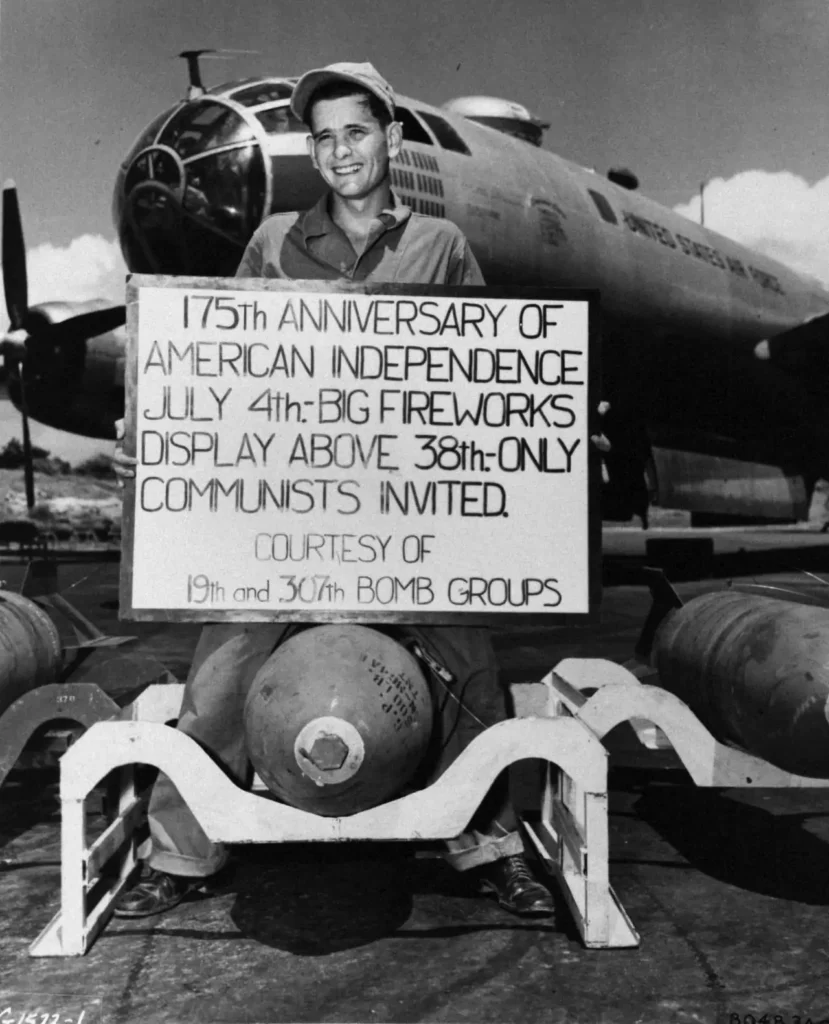
July 1951
The increase in the number of MiG-15 fighter jets and the improvement in the skills of enemy pilots prompted them to aim for air dominance down to the Pyongyang region. To avoid confrontation with the powerful jet fighter escorts accompanying B-29s of FEAF Bomber Command, the MiGs targeted vulnerable fighter-bomber and reconnaissance planes located north of Pyongyang.
The USAF F-86s, greatly outnumbered, faced the daunting task of defending not only the UN aircraft conducting reconnaissance and interdiction missions but also the bombers operating in the north as they engaged in a battle for air superiority against the MiG-15s.
- July 6
The first in-flight refueling over enemy territory during combat conditions was conducted by a KB-29M tanker from the Air Materiel Command, manned by a crew from the 43rd Air Refueling Squadron of the Strategic Air Command. This tanker refueled four RF-80 Shooting Stars as they flew reconnaissance missions over North Korea.
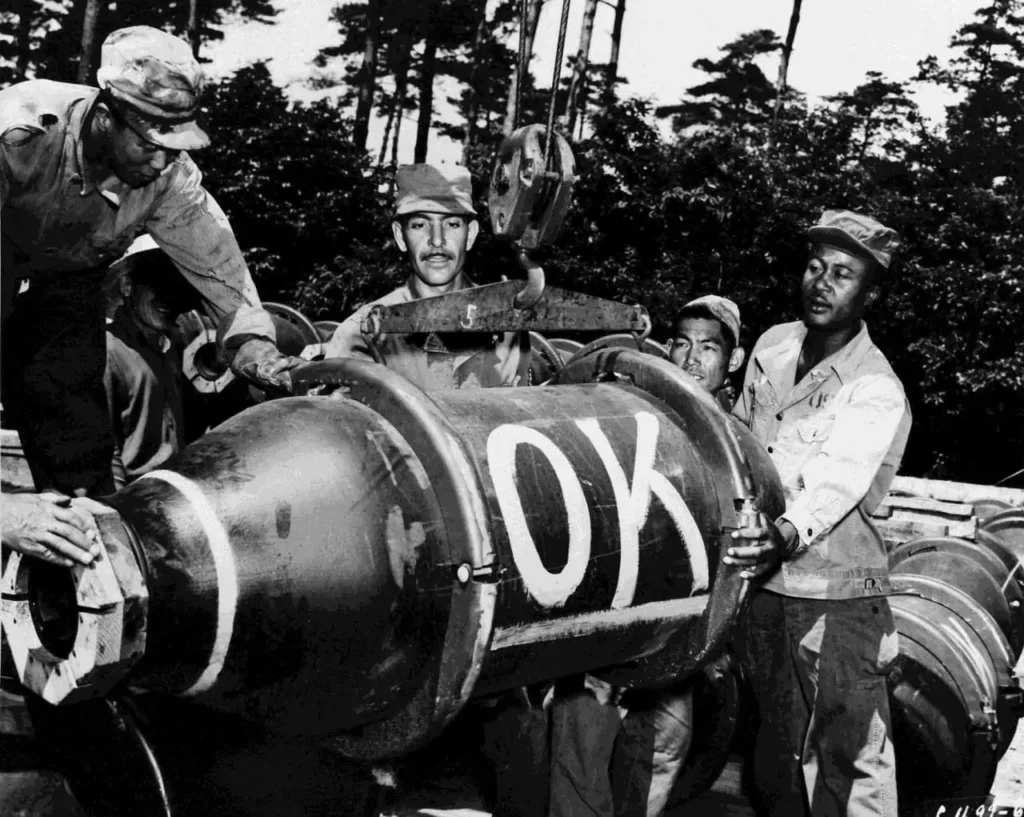
- July 22
B-29 lost: The B-29 was 44-62166 from the 307th Bombardment Wing. One of its engines caught fire, which quickly escalated and resulted in the aircraft exploding mid-air before crashing to the ground. The crash site was located northeast of Ocho-o, South Korea, between K-3 and K-18.
August 1951
Despite the unfavorable weather conditions that slowed down air operations, the Far East Air Force (FEAF) intensified its fighter-bomber campaign targeting the railroads in North Korea and sent B-29s to carry out SHORAN bombing attacks on enemy marshaling yards at night. The Far East Command (FEC) divided the responsibility of keeping the North Korean railway bridges down and rail lines cut among the Fifth Air Force, the FEAF Bomber Command, and the US Navy. The Bomber Command was able to destroy critical railway bridges.
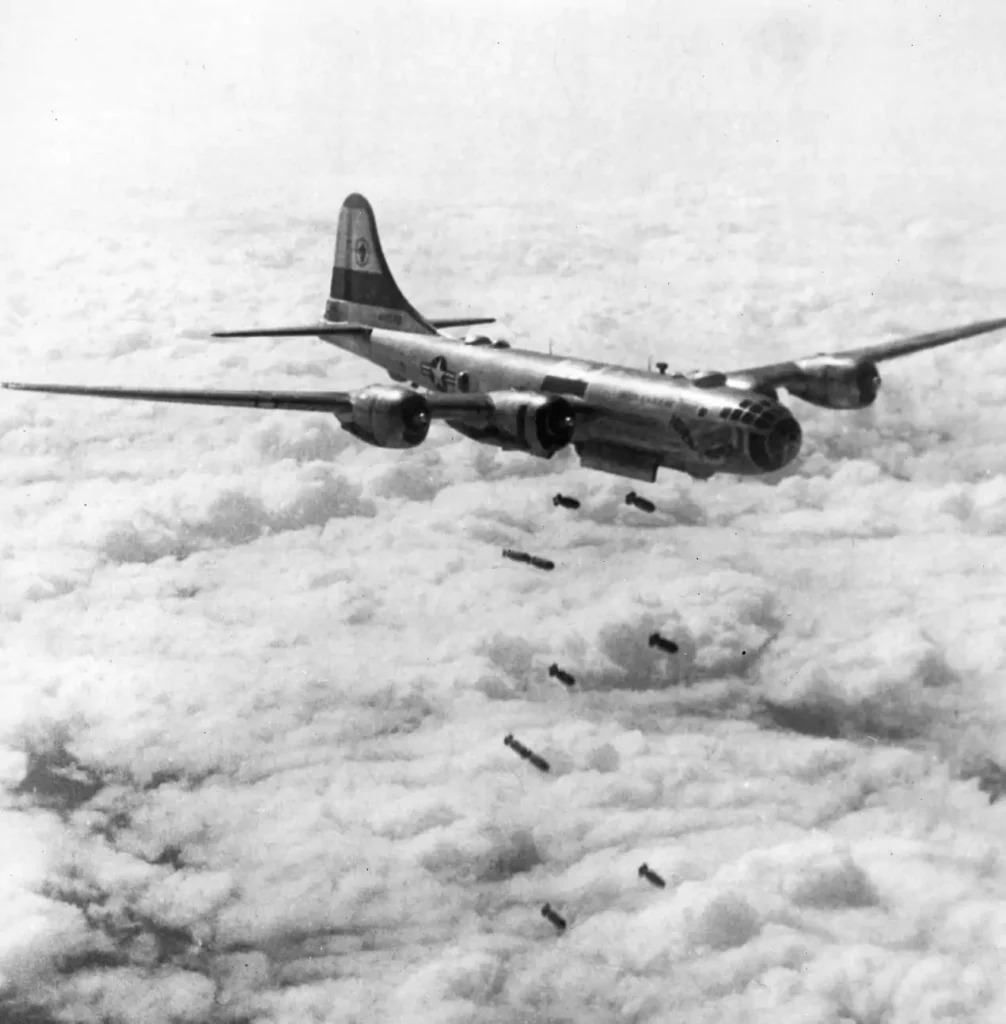
- August 17
B-29 operations were disrupted by a typhoon in Okinawa. - August 24
B-29 lost: During a bombing mission over Sunchon, North Korea, the aircraft, 44-86357, from the 307th Bomb Wing 372nd Bomb Squadron, was struck by antiaircraft fire and sustained significant damage. The pilot, in an attempt to evacuate the combat zone, flew the damaged plane to the west of the capital city. Due to the severity of the situation on board, the crew was forced to bail out and abandon the aircraft, which later crashed 17 km west of the Pyongyang-Sunan Airport. Sadly, one crew member did not survive, but the remaining 10 crew members were rescued. The aircraft was completely destroyed. - August 25
FEAF Bomber Command conducted its largest bombing mission of the month with 35 B-29s, escorted by U.S. Navy fighter jets, dropping 300 tons of bombs on the Rashin marshaling yards in northeast Korea. Despite its proximity to the Soviet border, Rashin, a major supply depot, was targeted as it had been previously excluded from the target list.
September 1951
On a daily basis, the FEAF Bomber Command carried out B-29 bombing missions aimed at key targets in North Korea, such as airfields, rail bridges, and marshaling yards. In addition to these interdiction sorties, the medium bombers would fly a small number of close air support, leaflet dissemination, and reconnaissance operations during nighttime.
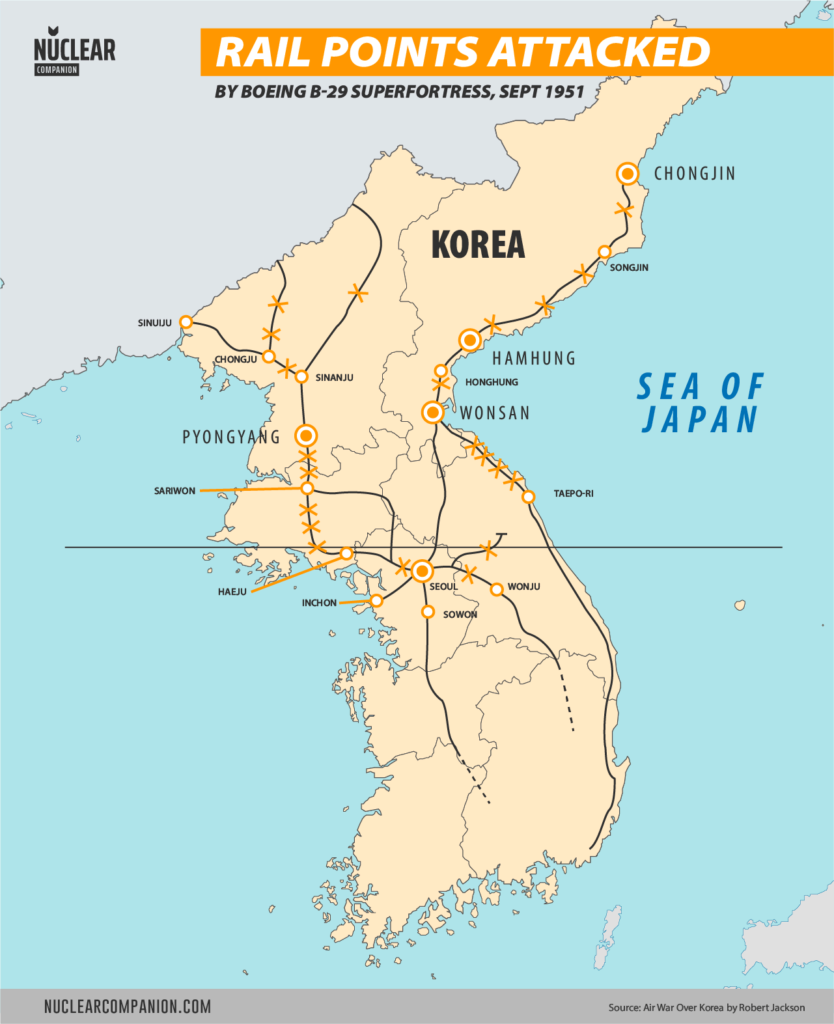
- September 13
B-29 lost: The B-29 bomber named United Notions with serial number 44-27326 from the 98th Bomb Wing crashed into a mountain 5 miles east of Taegu, South Korea. The accident occurred during an approach to Daegu Airport in reduced visibility, resulting in the death of all 14 crew members. - September 19
B-29 lost: 44-86415, 98th Bomb Wing 343rd Bomb Squadron, was on a mission to drop leaflets in North Korea when it was forced to ditch in the Sea of Japan. During the flight, a technical issue with the engine occurred, leading the pilot to make the decision to ditch the aircraft. Search and rescue operations were initiated but were eventually called off a few days later with no sign of the aircraft or its 14 crew members being found. - September 23
Eight B-29s from the 19th Bomb Group, showcasing their mastery of the SHORAN bombing technique, successfully destroyed the central span of the Sunchon railway bridge despite challenging conditions with a 9/10th cloud cover. - September 28
The longest flight in the history of jet aircraft using in-flight refueling was achieved by an RF-80 based in Yokota. The aircraft flew a combat mission in Korea for a total of 14 hours and 15 minutes, refueling multiple times from two KB-29M tankers.
October 1951
FEAF Bomber Command continued its daylight bombing operations against key North Korean targets, including airfields, rail bridges, and marshaling yards. Some night missions were devoted to close air support, leaflet drops, and reconnaissance. The enemy improved its searchlight technology, utilizing a larger number of higher-quality lights to track UN aircraft rapidly for flak or MiG attacks. Moreover, radar-controlled anti-aircraft guns in northwestern Korea posed a threat to B-29s, even at altitudes above 20,000 feet. However, in the last ten days of October, the downing of five medium bombers and damage to eight others by MiG-15s forced FEAF to halt daylight B-29 raids. Despite this, B-29 gunners managed to shoot down nine MiG-15s.

- October 2
B-29 lost: The B-29 bomber, named The Outlaw, with serial number 42-65306 and belonging to the 19th Bomb Group/28th Bomb Squadron, crashed during a test flight at Kadena AFB, Okinawa. The plane was one of the four flying in the first B-29 mission of the Korean Conflict on June 27, 1950. The reason for the crash is unknown, and the plane was damaged beyond repair. However, all six crew members were rescued. - October 14
B-29 lost: The B-29 bomber with serial number 44-86273, assigned to the 98th Bomb Wing and named Lil Darlin, crashed during landing at Yokota AFB in Tokyo. The aircraft had one inoperative engine due to a combat mission on the Korean War front. During the final approach, the airplane became unstable, and the pilot attempted a go-around. Unfortunately, the aircraft stalled and crashed just short of the runway threshold. The impact resulted in the destruction of the aircraft and the loss of nine crew members, while five others sustained injuries. - October 16/17
The highest number of sorties for the month, 31, were carried out by B-29 aircraft, including both day and night operations. These missions targeted rail bridges, marshaling yards, Saamchang Airfield, and also involved dropping leaflets and performing reconnaissance. - October 18
Nine B-29s from the 19th Bomb Group conducted an attack on Saamchon, while another nine from the 98th Bomb Wing targeted Taechon. The 19th Bomb Group managed to hit the target, dropping 306 100-pound bombs with success, while the 98th Bomb Wing failed to meet up with its fighter escort and proceeded to attack secondary objectives. The same situation occurred three days later, and no MiG fighter planes had yet attempted to defend the airfields. - October 22
B-29 lost: A bombing raid was conducted by the 19th Bomb Group with nine B-29s over Taechon Airport in North Korea, with the support of 24 F-84s. During the mission, the aircraft were engaged by 40 MiG-15 fighter planes. The B-29 named Cream of the Crop, sn 44-61656, was attacked by 2 or 3 MiG-15s at 1517LT, which caused engine number one to fail and the hydraulic system to be compromised. The pilot managed to navigate the aircraft away from the combat area, but ultimately, all 12 crew members had to abandon the plane, which crashed into the Yellow Sea. The B-29 was lost, but all 12 crew members were rescued, with two sustaining injuries.
The crew of the B-29 that had been shot down was saved by two SA-16 aircraft of the 3rd Air Rescue Squadron. This was the largest number of individuals saved in a single day by an SA-16 during the war. The B-29 that crashed into the Yellow Sea was assigned to the 19th Bomb Group’s 30th Bomb Squadron. The Soviet MiG-15 that shot down the aircraft was flown by Lt. Col Aleksandr P. Smorchkov. - October 23 – Black Tuesday
The battle was one of the deadliest air battles during the Korean War. The 307th Bomb Wing conducted a bombing raid on Namsi Airfield with nine B-29s sent in three flights. However, the mission was met with fierce resistance from an estimated 84 MiG-15 fighter planes, resulting in the destruction of three B-29s.
The attack on Namsi had been planned using the SHORAN system, which led the bombers directly overhead the airfield of Taechon and its formidable anti-aircraft batteries. The aircraft were damaged by anti-aircraft fire as they overflew, making them vulnerable to MiG attack. Soviet radars detected the raid, and three regiments of the 303rd IAD were launched to intercept, followed by two regiments of the 324th IAD. The MiGs split their force to keep the F-86s tied up and swept down through the F-84 escort, causing significant damage to the B-29s. Three bombers were shot down, three more were so badly damaged that they had to divert to Kimpo to make emergency landings, and the remaining three aircraft recovered to Okinawa, but two of them were also seriously damaged. One F-84 and four MiG-15s were lost in the battle, and three additional MiG-15s were damaged.
| Flight | Captain | Serial number | Unit | Result | Remarks |
|---|---|---|---|---|---|
| A Flight | Clarence I. Fogler | 44-61816 | 307BG/371BS | Major battle damage | Landed at Kimpo with over 500 holes in plane |
| A Flight | James R. Lewis | 44-87760 | 307BG/371BS | Major battle damage | |
| A Flight | Robert M. Krumm | 42-94045 | 307BG/371BS | Destroyed | Shot down by Lt. Col Aleksandr P. Smorchkov at Namsi, North Korea |
| B Flight | William Reeter | 44-86295 | 307BW/372BS | Major battle damage | Badly damaged, transferred to Depot for disposition. Depot repaired, returned to duty. Next assignment unknown. |
| B Flight | James A. Foulks | 44-61940 | 307BW/372BS | Destroyed | Shot down on Namsi Airfield raid, crashed in Yellow Sea. |
| B Flight | William P. Griner | 44-27347 | 307BW/372BS | Major battle damage | Badly damaged, transferred to Depot for disposition. Depot repaired, returned to duty. Next assignment unknown. |
| C Flight | Thomas L. Shields | 44-70151 | 307BG/370BS | Destroyed | Shot up by D’Yachenko at Namsi, abandoned Inchon area |
| C Flight | Donald L. Field | 44-86395 | 307BG/370BS | No significant damage | |
| C Flight | Peter Dempsey | 44-61824 | 307BG/370BS | Major battle damage |
- October 24
B-29 lost: Eight B-29s belonging to the 98th Bomb Wing attacked the bypass railway bridges in Sunchon, with support from 16 Royal Australian Air Force Gloster Meteors and 10 F-84s. They were engaged by 70 MiGs, resulting in one B-29 being shot down and seven others suffering significant damage.
The B-29 bomber lost was named Our Girl, sn 44-61932, belonging to the 98th Bomb Wing’s 343rd Bomb Squadron. It was shot down over Wonsan Harbor by several Soviet MiG-15 pilots led by Lt. Col Aleksandr P. Smorchkov. Following the attack, all 11 crew members were able to bail out of the aircraft before it crashed into the harbor. Two crew members lost their lives, but the remaining nine were rescued. - October 27
- MiG fighter jets conducted about 200 sorties, which was the highest number for the month. During the last daytime raid by medium bombers that month, B-29 gunners successfully shot down six MiG-15s, the most enemy aircraft taken down in a single day during the war.
- B-29 lost: The B-29 bomber with serial number 44-62071 and assigned to the 19th Bomb Group’s 30th Bomb Squadron was hit by Soviet MiG-15 enemy fire during a bombing mission. Despite the damage, the crew managed to fly the aircraft back to Seoul and crash-landed at K-14. It was later salvaged. Senior Lieutenant Dmitri Samoy piloted the Soviet MiG-15. During the crash landing, all 11 occupants of the aircraft were injured, and the plane was destroyed.
- October 31
B-29 lost: After taking off from Kadena Airbase and en route to Korea, the B-29 bomber named Dragon Lady, with serial number 44-61835 and assigned to the 19th Bomb Group’s 30th Bomb Squadron, experienced an engine explosion on the third engine. The pilot attempted to return to Kadena but the right wing was blown off, causing the aircraft to lose control and crash into the sea approximately 65 km north of Kadena and 15 km west of Izenajima Island. The incident occurred about 15 minutes after takeoff. Among the 15 crew members on board, 12 were killed and three were rescued.
November 1951
The light bombers of the Fifth Air Force and the B-29s of the FEAF Bomber Command carried out nightly assaults on crucial rail bridges and marshaling yards. At night, medium bombers targeted jet airfields in northwest Korea, including Saamchain, Taechon, and Namsi, to prevent their usage. The enemy’s jet fighters were based at an airbase in Uiju along the Yalu River for a brief period, but sustained attacks from B-29s quickly made it unusable. Despite increased activity by enemy night interceptors in northwest Korea, not a single B-29 was brought down.

- November 9
- The marshaling yards at Hwang-ju, Kowon, and Yangdok, the Saamcham Airfield, and a barracks area were the targets of the 19th Bomb Group’s attack. Meanwhile, B-29s of the 98th Bomb Wing conducted night attacks on Taechon Airfield, flew one leaflet and five close support sorties, and targeted Hungnam.
- B-29 lost: The B-29 bomber named Bigham with serial number 42-93974 from 98th Bomb Wing 343rd Bomb Squadron was forced to be abandoned due to flak damage during a leaflet-dropping mission over North Korea. The aircraft was shot down by the enemy antiaircraft fire, and all 12 crew members decided to bail out. The plane crashed near Chongju, and 11 crew members were rescued by friendly forces. Unfortunately, the captain became a POW. A C-47 conducted a rescue mission and landed on the beach of Paengnyong-do Island, off the southwest coast of North Korea, to retrieve the eleven crewmen of the downed B-29.
- November 18
B-29 lost: The B-29 bomber named 44-86247 and assigned to the 98th Bomb Wing’s 344th Bomb Squadron crashed during takeoff at Yokota Air Base. The pilot attempted an emergency braking procedure, but the aircraft was unable to stop and overran the runway, ultimately coming to rest in flames. Although all eleven crew members were able to evacuate safely, the aircraft was carrying several bombs which exploded and caused the deaths of ten rescuers, including three Americans and seven Japanese individuals.
December 1951
FEAF Bomber Command conducted nighttime operations, dropping air fragmentation bombs on enemy positions and troops beyond the reach of friendly artillery. They repeatedly targeted crucial bypass bridges, marshaling yards, and highway bridges along enemy supply routes, mainly in western and northwestern Korea. The enemy airfields at Namsi, Taechon, and Saamcham were kept out of operation through almost daily B-29 attacks. Despite the rise in enemy air resistance and antiaircraft fire, no B-29s were lost during the month.
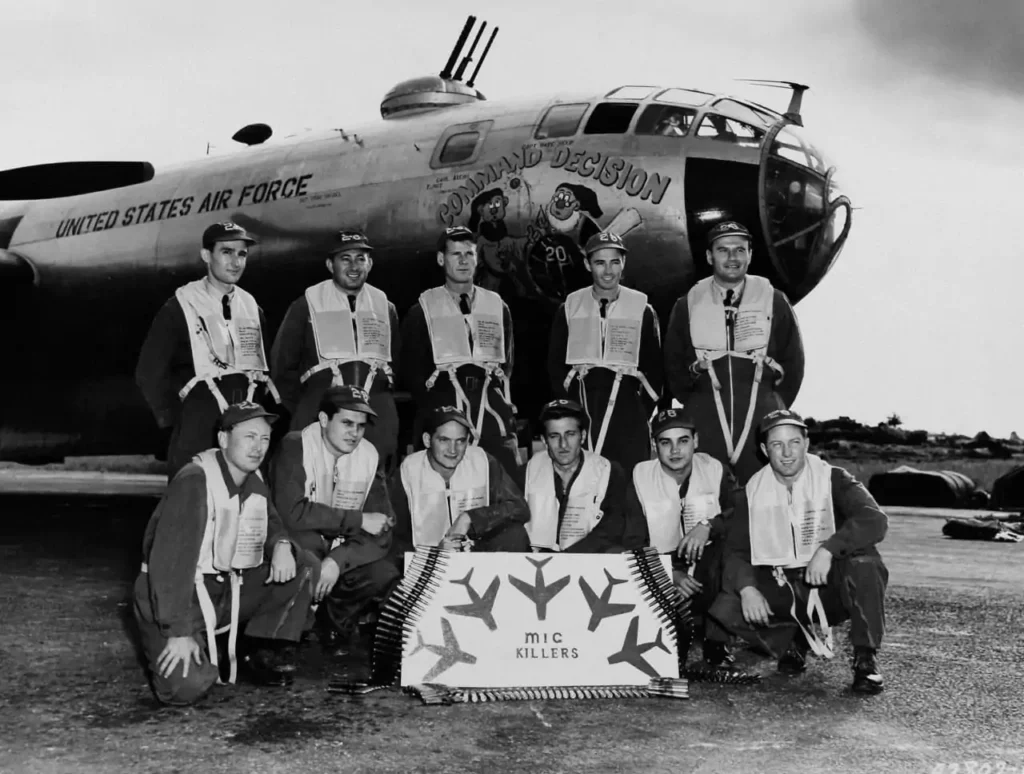
- December 4
B-29 lost: A B-29 bomber with serial number 44-27314, assigned to the 370th Bomb Squadron of the 307th Bomb Wing, crashed about two miles east of Kadena AFB, Okinawa. The aircraft was en route to Korea when it went out of control less than three minutes after takeoff and crashed in a field. The crash resulted in the death of nine crew members, while three others sustained injuries. - December 14
During the night, B-29s from the 19th Bomb Group caused significant damage to the marshaling yards at Maengjung-dong. - December 18
B-29 lost: The B-29 bomber, with the serial number 44-70042 and assigned to the 28th Bomb Squadron of the 19th Bomb Group, known as “Lemon Drop Kid,” was lost under unknown circumstances.
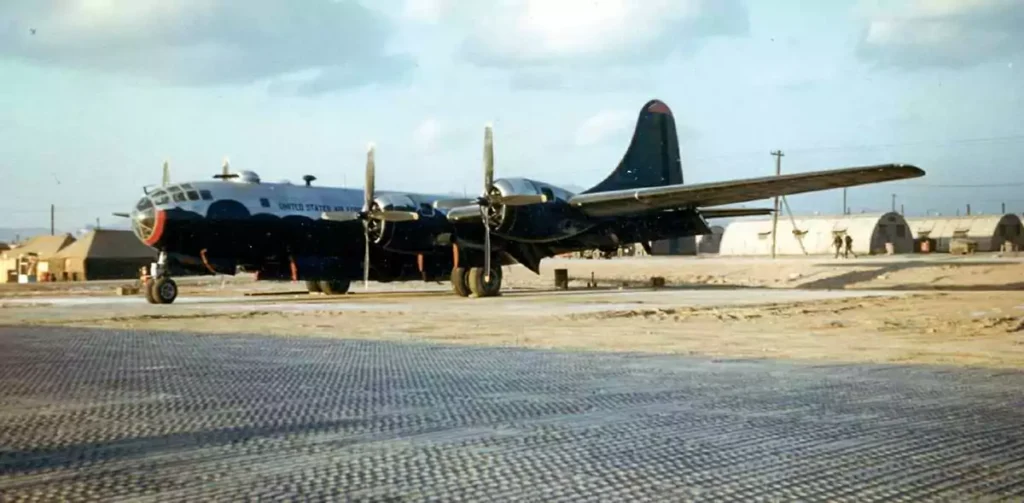
- December 19
The 307th Bombardment Wing dispatched ten B-29 bombers to target the marshaling yards at Chongju. - December 24
On a typical night mission, the 98th Bomb Wing sent B-29s to bomb the Taechon Airfield runway, leaving craters, and the Sinanju railroad bridge.
January 1952
The priority for FEAF Bomber Command was to keep North Korean airfields non-operational by bombing them regularly. Along with airfields, the B-29s also targeted marshaling yards, bridges on bypassed railroads, and supply storage facilities. The aircrews were cautious to avoid bombing areas near reported prisoner-of-war camps. Additionally, they flew night sorties to provide close air support by dropping bombs on enemy troops.

- January 12/13
Ten B-29 Superfortresses stationed in Okinawa effectively took out the railway bridge over the Chongchong River east of Sinanju by dropping 396 high-explosive 500-pound bombs, rendering it inoperable. - January 23
B-29 lost: 44-87734, from 19 Bomb Group 93 Bomb Squadron named Double Whammy, was one of the four planes that flew the first B-29 mission of the Korean Conflict. While en route from Kadena Airbase and approaching the North Korean coast, the heavy bomber suffered an engine failure and was unable to feather the prop. The crew notified Air Group Command that they were aborting and heading to K-14. However, following a search, no trace of the plane or its 14 crew members was found. The aircraft crashed into the Yellow Sea a few kilometers off Nampo. - January 29
B-29 lost: The heavy bomber named Heavenly Laden, bearing the serial number 45-21822 and assigned to the 344 Bomb Squadron of the 98 Bomb Wing, suffered an engine fire while in flight. The crew decided to abandon the aircraft, and all 13 members successfully bailed out before the plane crashed into a mountainous region located 7 km west of Yokosuka. Although the airplane was destroyed, all crew members were found alive. - January 31
B-29 lost: On a mission to Korea, a b-29 bomber with serial number 44-62083 and belonging to the 307 Bomb Wing 372 Bomb Squadron took off from Kadena AFB. The last radio contact with the aircraft was made at around 2154LT, while it was flying about 100 miles north of its departure point. Despite conducting SAR operations, no trace of the plane or its crew was found and the search was eventually suspended.
February 1952
The air interdiction campaign known as Operation Saturate intensified, pitting U.S. airmen against North Korean laborers in a race to destroy and repair rail lines. In a single night, up to 40 B-29s from FEAF Bomber Command could strike a bridge, and fighter bombers would drop over 500 bombs on a stretch of track, only to see it restored within a couple of days.
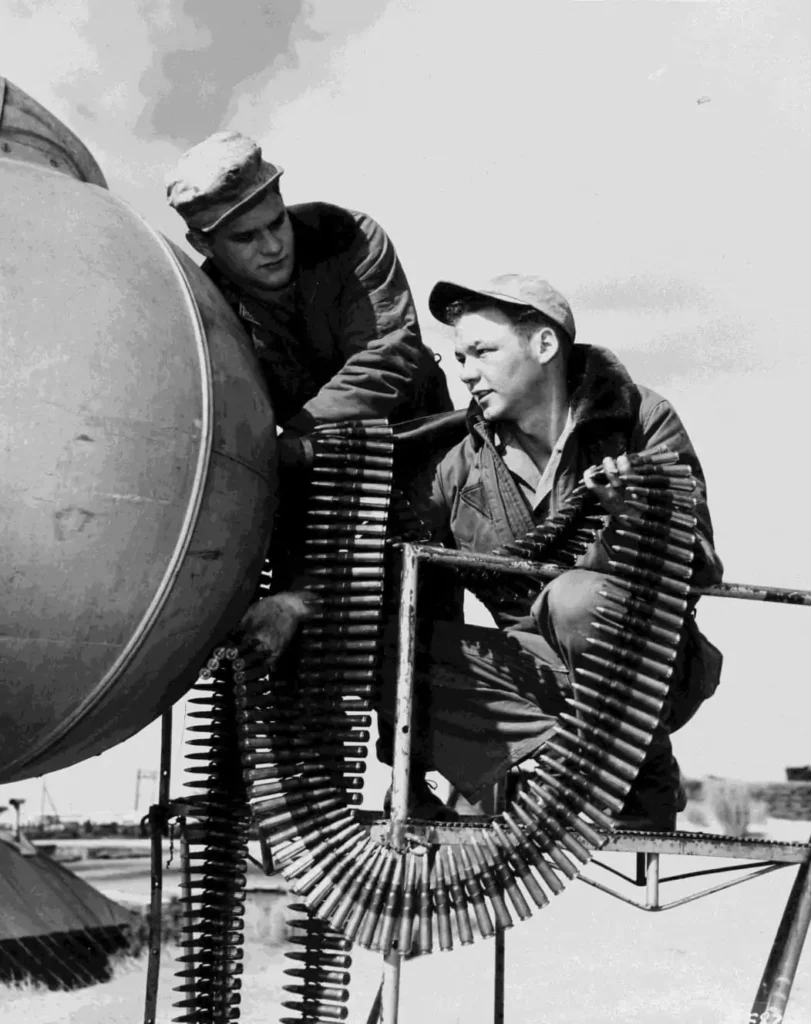
The B-29s focused their efforts primarily on rail crossings, crucial bridges, and marshaling yards, as most North Korean airfields were still unusable. To put pressure on the enemy’s antiaircraft defenses, the B-29s moved from attacking heavily defended bridges to less vulnerable targets. They also provided close air support by dropping air-fragmentation bombs over enemy troop concentrations near the front line.
- February 1
B-29 lost: On February 1, 1952, a B-29 with the serial number 44-61908 from the 307 Bomb Wing stationed at Okinawa crashed into the Sea of Japan, resulting in the loss of all 12 crew members. The wing of the bomber was hit by another B-29, 42-65392, during a training flight. The collision took place ten miles northwest of Kadena AFB in Okinawa, causing both planes to crash. Unfortunately, there were no survivors from B-29 44-61908, however, B-29 42-65392 was able to land safely without any fatalities.
- February 7
B-29 lost: The B-29 with serial number 45-21721 from the 98th Bomb Wing 345th Bomb Squadron crashed in a snowstorm five miles north of Yokota AFB after takeoff. As the aircraft was ascending in the snowy weather, it lost control and crashed in a large explosion on multiple homes located approximately 5 km northwest of the airfield. Sadly, all 13 crew members and five individuals on the ground lost their lives.

- February 9
In a standard operation, a group of ten B-29s utilized radar-guided techniques to bomb the north bypass rail bridge in Chongju with a total of 100 tons of 500-pound high-explosive bombs, making it unusable. - February 26
Ten B-29s, utilizing radar-assisted targeting, unleashed 100 tons of bombs on the Sinhung-dong railway bridge near Huichon in north-central Korea, effectively destroying two sections of the bridge. - February 28
B-29 lost: 44-69803, a B-29 named “Loaded ‘Leven” from the 98 Bomb Wing 344 Bomb Squadron, experienced engine trouble and eventually crashed into the sea a few kilometers west of Kaesŏng. Seven crew members were able to bail out and were later rescued, however, five others lost their lives in the crash.
March 1952
FEAF Bomber Command B-29s carried out nightly bombing raids on crucial targets of the communist forces, including enemy troops and supply storage areas located near the front line, using radar guidance to direct their bombs.
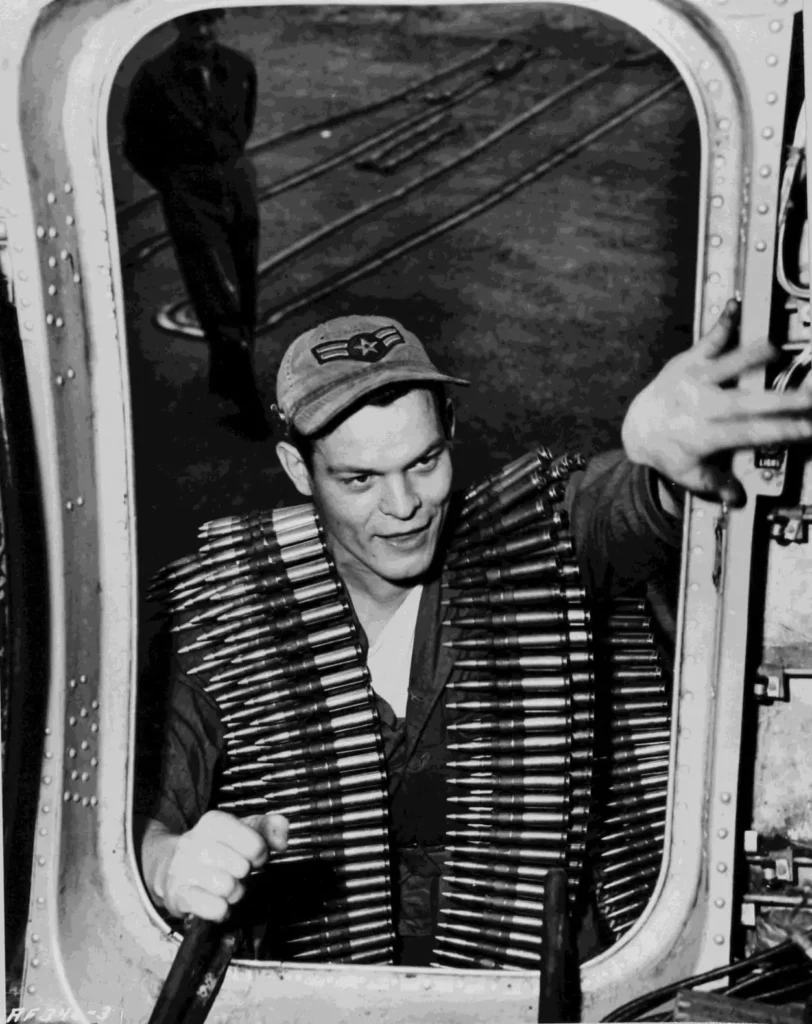
- March 11/12
Ten B-29s from FEAF Bomber Command dropped ninety-one tons of high explosive bombs on the Sinchang-ni chokepoint, located ten miles east of Sunchon, making it inaccessible. - March 31
- B-29 lost: 44-61776, a B-29 from the 98 Bomb Wing 343 Bomb Squadron named Rapid Rabbit, suffered engine failure during flight. The crew had to abandon the plane 3 miles north of Kaesong, Korea. All 11 crew members were able to bail out successfully and were later found to be alive. However, the heavy bomber crashed into the ground resulting in the complete destruction of the aircraft.
- B-29 lost: During a takeoff from Yokota Air Base a B-29, with serial number 44-86400 and part of the 98 Bomb Group 344 Bomb Squadron, collided with the side of a mountain near Saimon village, located approximately 10 km northwest of the airbase. Tragically, nine out of the eleven crew members lost their lives while two were rescued.
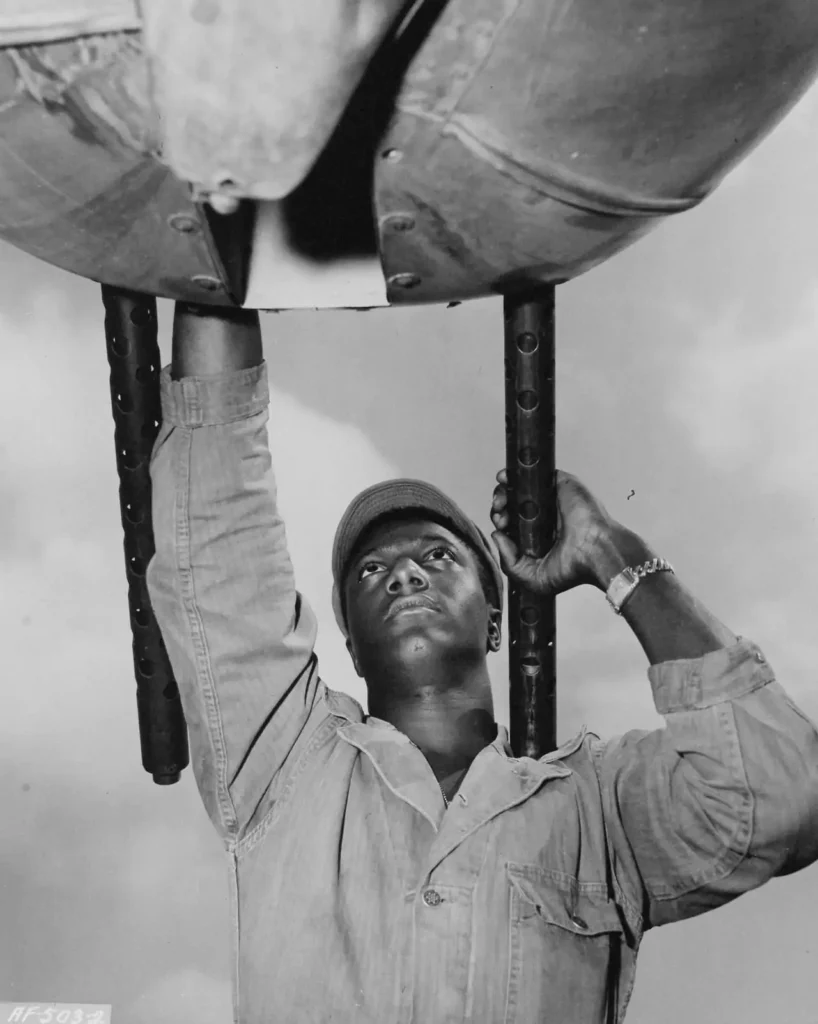
April 1952
FEAF Bomber Command’s B-29s primarily focused their bombing efforts on North Korean road bridges, railway bridges, and marshaling yards, with a small number of missions dedicated to close air support and leaflet distribution. The 91st Strategic Reconnaissance Squadron’s RB-29s conducted reconnaissance of chosen North Korean targets, while the 2143d Air Weather Wing’s WB-29s flew weather reconnaissance missions.

- March 31/April 1
- FEAF Bomber Command dispatched twenty-nine B-29 sorties, nearly double the regular number, primarily targeting the Sinhungdong rail bridge and the Kwaksan railway track.
- April 12
B-29 lost: B-29 with serial number 44-62252, assigned to 307th Bomb Wing, 371st Bomb Squadron, was lost on a mission. The aircraft was participating in a daylight mission aimed at destroying railway bridges across the Yalu river in Sinuiju and Antung. This mission was so perilous for the air force that in the following days, the planes were painted black on the bottom for safer night-time raids. The B-29 served as the electronic countermeasures aircraft and was responsible for confusing enemy ground radar through electronic jamming equipment and the dropping of aluminum foil strips known as chaff. It was in the slot position of the second group, which put it in the middle of three groups with some space between each group. The aircraft experienced engine trouble, which caused it to slow down. Rather than slowing down its own group, it dropped from its position to become the lead plane of the next group. It was during this brief moment that the Russian-piloted MiG-15s attacked, finding the lone B-29 between the two groups. The aircraft was damaged in the attack and a fire erupted, causing seven crew members to bail out and become prisoners of war. The remaining crew managed to extinguish the fire and nurse the aircraft back to Suwon AFB in South Korea, but the damage was too severe, and the crew bailed out, causing the aircraft to crash into a hill near Suwon, 10 miles south of Seoul. Salvaged 5/14/52
May 1952
The UN Commander agreed with the recommendation from the FEAF Commander to target North Korea’s hydroelectric power plants as a cost-effective way to make the enemy leadership understand the increasing consequences of their stubbornness during armistice negotiations.
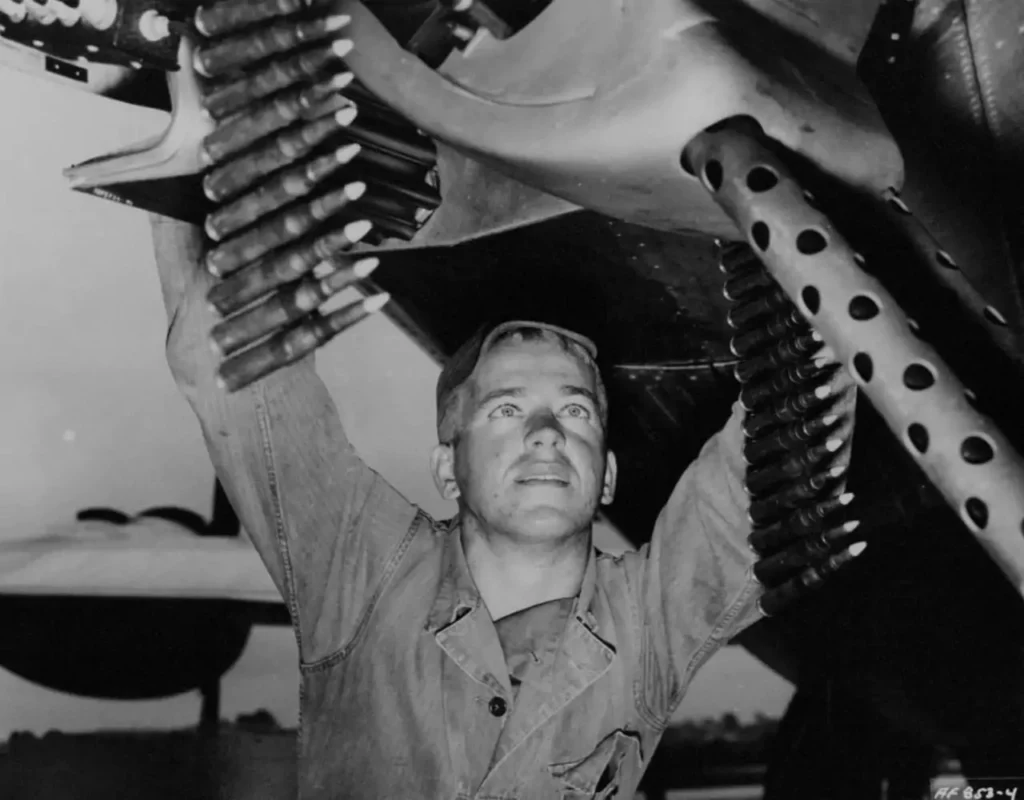
- May 5
B-29 lost: A B-29, serial number 44-61693, from the 19th Bomb Group 30th Bomb Squadron was lost with the surrounding circumstances unknown. - May 26/27
Ten medium bombers from the 19th Bomb Group carried out an attack on the Sinhung-dong railway bridge, causing significant damage including the destruction of a single locomotive, sixteen rail cars, and a portion of the bridge measuring 350 feet in length along with nearly 400 feet of track near the approaches.
June 1952
Over 1,200 sorties were flown by aircraft from the Fifth Air Force, FEAF Bomber Command, and Naval Forces Far East against North Korean hydroelectric power facilities. As a result, 11 out of the 13 power plants were made unserviceable, and more than 90% of North Korea’s and 25% of Manchuria’s electric power capacity was destroyed.

- June 7
The initiation of an air refueling experiment called Operation Hightide, saw thirty-five F-84 Thunderjet fighter aircraft depart from Japan. During the mission, they were refueled mid-air over Korea by KB-29M tanker planes and went on to strike targets in northern Korea. - June 9
B-29 lost: B-29, serial number 44-62207 from the 98th Bomb Wing, 344th Bomb Squadron, crashed at K-2 in Daegu after encountering battle damage. The crew had to divert to K-2 due to unfavorable weather conditions at Yokota Air Base in Japan and mistakenly landed on a runway that was under construction. The aircraft sustained significant damage, but fortunately, the crew members were unharmed. - June 10/11
B-29 lost: Eight B-29 bombers from the 19th Bomb Group conducted an attack on the rail bridge at Kwaksan in North Korea. The enemy MiGs, equipped with radar-controlled searchlights and anti-aircraft artillery, shot down two of the B-29s and seriously damaged a third. In response to this new advancement in the enemy’s air defense system, the Far East Air Force (FEAF) sought to improve its electronic countermeasures to jam and confuse enemy radar.
One of the fallen B-29s was 44-62183, belonging to the 19th Bomb Group’s 28th Bomb Squadron, named “Hot to Go”. It was brought down by rockets fired by a MiG-15, piloted by Karelin, a Soviet pilot. The other lost B-29 was 44-61967, a part of the 19th Bomb Group’s 30th Bomb Squadron, named “Miss Jackie the Rebel”. It was reported to have been hit by anti-aircraft fire near the bridge at Kwakson in North Korea. Evidence suggests that it was shot down by a MiG.
- June 13
B-29 lost: The B-29, named Ichiban and sn 44-61810, was part of the 91st Strategic Reconnaissance Squadron. The aircraft was shot down near Hokkaido Island by Soviet MIG 15 pilots Fedotov and Proskurin. - June 19/20
Approximately three times the average number of B-29s sorties for the month were flown, totaling 35, against North Korean targets. Out of these, 27 medium bombers specifically targeted the rail bridge at Huichon. - June 24/25
Twenty-six B-29s carried out close air support operations, which was one of the largest missions of its kind for medium bombers since the beginning of the conflict.
July 1952
The FEAF Bomber Command aimed its B-29s at key targets such as communication hubs, production plants, and supply depots. The plan was for the B-29s to strike 60 to 80 diverse targets per month. However, when there were no suitable air targets available, many B-29s were redirected to attack North Korean railway marshaling yards, with little to show for it.
- July 4
B-29 lost: RB-29 44-61727 from the 91st Strategic Reconnaissance Squadron was brought down by enemy fire from a Soviet MiG-15. Out of the 13 crew members on board, 11 were taken captive as POWs while the other two were killed in the crash. The aircraft was cruising at an altitude of 7,200 meters when it was targeted by the enemy fighter. The plane spun out of control and crashed into the ground, partially disintegrating and losing all four engines before impact. - July 11/12
As a part of Operation Pressure Pump, seventy-one successful bombing missions were carried out by B-29s, with over half of them targeting the supply region around Pyongyang. - July 30/31
In one of the largest medium bomber raids, 60 B-29s inflicted significant damage to the Oriental Light Metals Company, located just 4 miles from the Yalu River. Despite facing the toughest nighttime air defense from the enemy yet, the bombers successfully demolished nearly 90% of the facility. Remarkably, no B-29s were lost during the attack.
August 1952
Despite the conclusion of FEAF intelligence that North Korea had no further strategic or economic targets to strike, B-29 and fighter-bomber attacks by the Fifth Air Force continued against communist areas of supply and production. The medium bombers made five-night raids on Pyongyang, some of the largest and most intense attacks of the conflict.
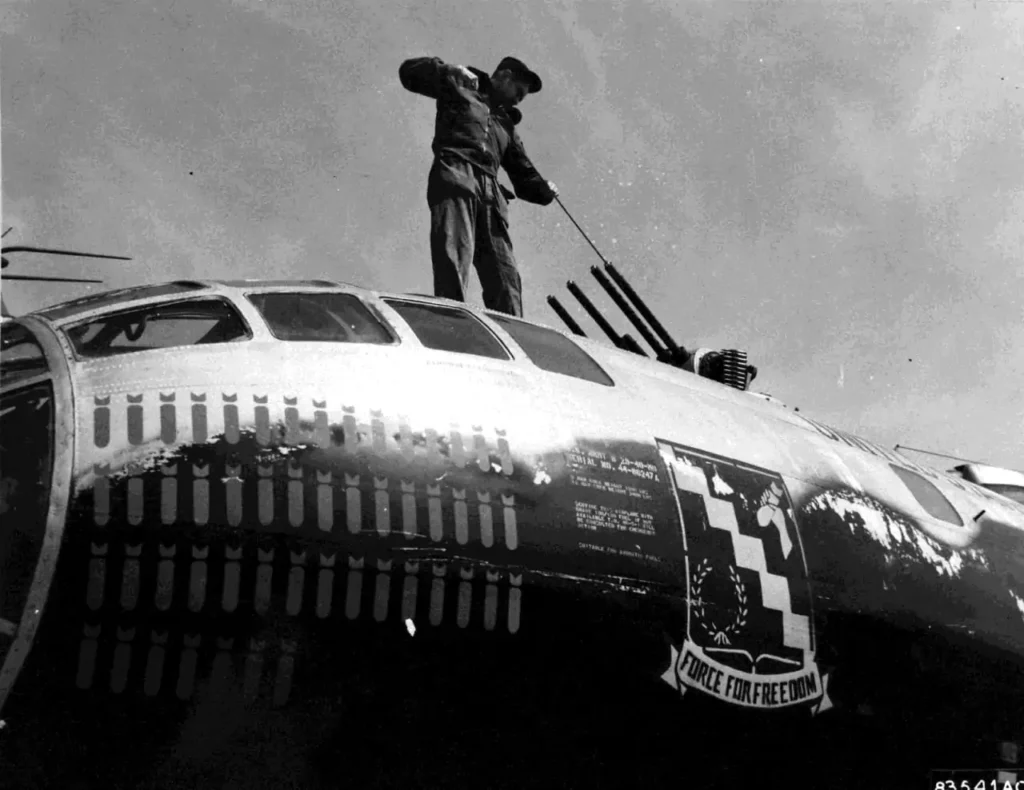
- August 6
B-29 lost: B-29 44-62237, belonging to the 98 Bomb Wing, experienced a crash during takeoff at Yokota AFB. Upon climbing to a height of 150 feet after takeoff, the number four engine caught fire. The plane continued its ascent until it reached 500 feet, at which point the number two engine also caught fire. At 600 feet, there were two explosions in engine two, and at 650 feet, nine crew members chose to bail out. Sadly, the plane stalled and crashed in flames about 10 km from the airbase, resulting in the deaths of three crew members. The remaining crew members who bailed out were successfully rescued.
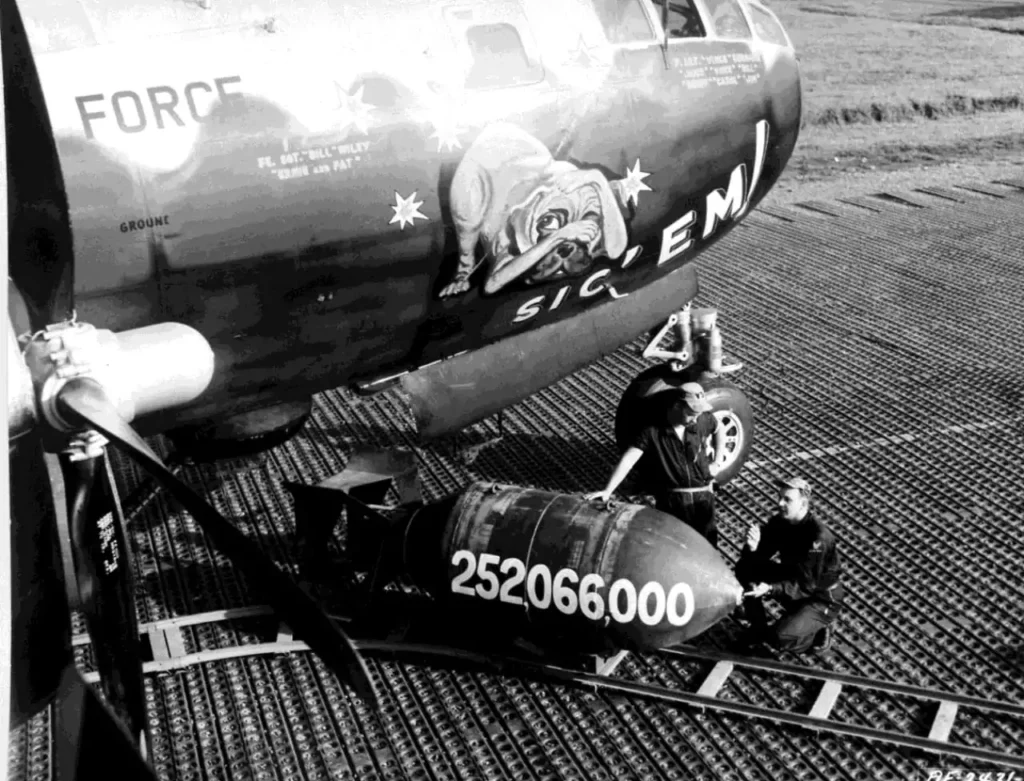
- August 20/21
During this month, the highest number of medium bomber sorties against a single target was carried out by thirty-eight B-29s bombing the enemy’s capital’s supply areas. - August 30
B-29 lost: A b-29 bomber named “Bust in the Blue” (44-62167) from the 98th Bomb Wing’s 344th Bomb Squadron crashed 4 miles east of K-2 in Daegu, following a missed approach. As the aircraft was on its final approach to Daegu Airport, the pilot in command decided to abort the landing and go around, however, the aircraft lost control and crashed into a mountainous area located about 6 km northeast of the airport. Tragically, all 12 crew members lost their lives.
September 1952
The Far East Air Force (FEAF) primarily aimed its air assaults at remaining industrial targets and areas of enemy troop concentrations across North Korea, including regions that had not yet been targeted by previous FEAF attacks. In a new development, the FEAF Bomber Command utilized a small number of B-29s solely for electronic countermeasures (ECM).

- September 3/4
A total of fifty-two successful B-29 bombing sorties were flown, with a record number of 50 of these missions targeting the Changjin hydroelectric power plant complex. - September 12
B-29 lost: B-29 44-69802 from the 19th Bomb Group 28th Bomb Squadron met its demise in a crash 21 miles southwest of Kangnung, South Korea. The bomber took off from Kadena AFB and was headed toward North Korea. However, the crew encountered severe icing conditions that caused the aircraft to stall and lose control. Sadly, 11 crew members lost their lives, while only one was rescued. - September 12/13
B-29 lost: Twenty-five B-29 bombers targeted the generator building at the massive Sui-ho power plant. To clear the way for the attack, low-level fragmentation bombs were dropped by USAF B-26s and USN aircraft, making eight of the approximately thirty searchlights inoperative. Meanwhile, four B-29s orbiting to the east jammed enemy radar. Although one medium bomber was shot down by enemy fighters and several others sustained flak damage, the B-29s were able to drop their bombs on target, again disabling the plant. The Far East Air Force (FEAF) believed that the searchlight suppression and electronic countermeasures (ECM) probably saved the B-29s from more significant losses. The lost B-29 was serial number 44-86343 and belonged to the 307 Bomb Wing, 371 Bomb Squadron. - September 19
The first medium bomber daylight raid in 11 months took place with 32 B-29s and F-86 escorts attacking enemy barracks and two supply areas southwest of Hamhung. The attack was preceded by an RB-45 and supported by an RB-29 which orbited the assembly area and provided weather information.
October 1952
The B-29 medium bombers from FEAF Bomber Command conducted frequent raids on various targets in North Korea, repeatedly hitting supply complexes. They struck storage facilities in the vicinity of Sopo-ri, Naewonson-ni, Haechong, Ponchongol, Yonpo, and Chinnampo, as well as a command and training center on the Haeju peninsula. Additionally, the B-29s carried out close air support missions utilizing underground radar guidance.
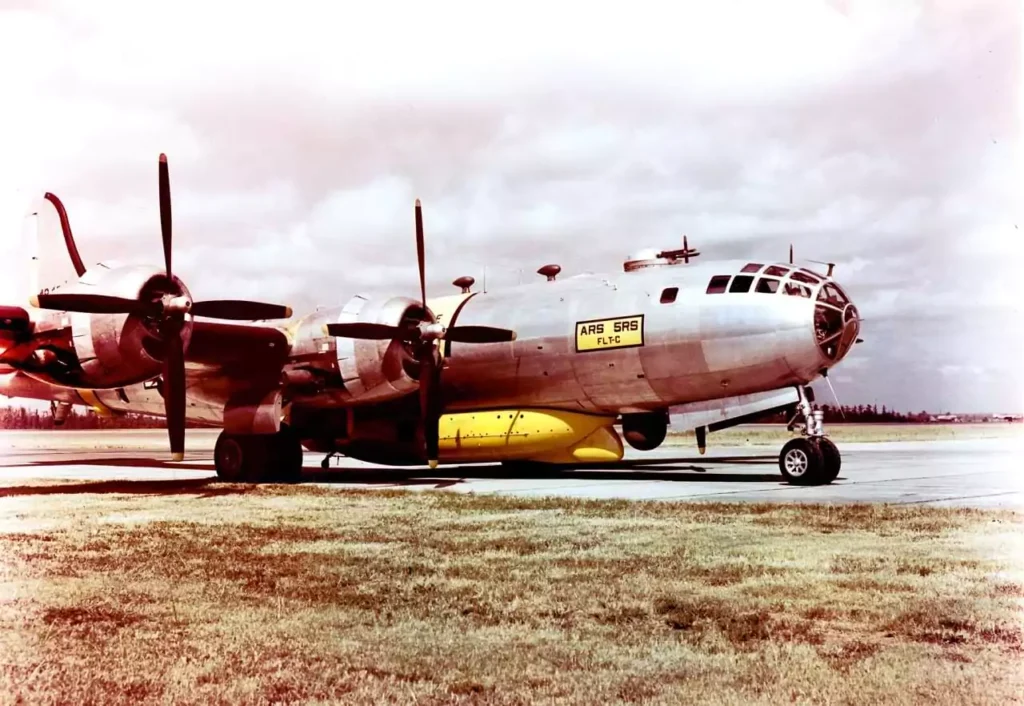
- September 30/October 1
With the inclusion of five electronic countermeasures (ECM) aircraft designed to suppress enemy flak, forty-eight B-29 medium bombers from three units – the 19th Bomb Group, and the 98th and 307th Bomb Wings – successfully destroyed the Namsan-ni Chemical Plant, which was the final target of strategic significance in Korea. The plant was located just 1,300 feet from the Yalu River and near the Sui-ho Dam. Seven B-26 aircraft flew in at low altitudes during the bombing to disable eight out of approximately forty enemy searchlights. - October 8
Ten B-29 bombers from the 98th Bomb Wing conducted a daylight bombing mission on the Kowon supply area in eastern Korea, supporting an amphibious hoax. The mission was coordinated with fighter-bomber attacks by the U.S. Navy. - October 12/13
Twenty-six B-29 medium bombers from the 19th Bomb Group, 98th Bomb Wing, and 307th Bomb Wing targeted nine different enemy troop gatherings on the Haeju peninsula. - October 31
B-29 lost: B-29 44-61751, known as “Lubricating Lady,” belonging to the 19th Bomb Group 93rd Bomb Squadron, had to ditch into the North China Sea nine miles northwest of Kadena, Okinawa due to a typhoon. The fateful event took place on Halloween night at 11:59 PM. As the bomber was on approach to Kadena Air Force Base, it suddenly lost control and crashed into the ocean. Despite extensive search and rescue efforts, only three crew members were saved, while 11 others perished in the crash.
November 1952
The primary focus of Bomber Command’s B-29 attacks was on troop concentrations, communications centers, and supply hubs. Typically, two targets were hit each night, with six B-29s assigned to each. Evaluation of bomb damage photos showed a significant improvement in B-29 bombing accuracy, which was attributed to better target identification through the use of the 1st SHORAN Beacon Squadron’s advanced SHORAN technology. However, as enemy air defenses grew stronger, Bomber Command suffered a loss of one B-29 in November. To mitigate this risk, the command compressed the bomber formation and increased the use of ECM. In response to the growing number of enemy night interceptors, the 319th FIS started using F-94B Starfighters to escort B-29s on bombing missions and to create a barrier between the Yalu and Chongchon rivers.
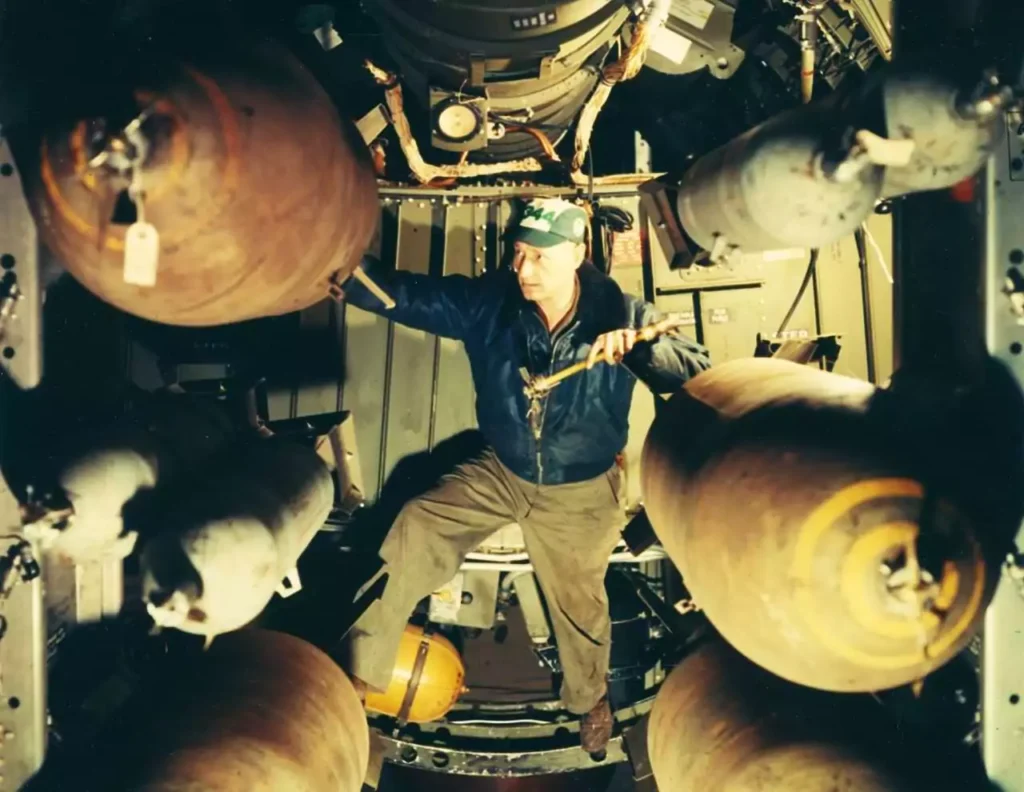
- November 5
Due to the typhoon conditions in Okinawa, all planned B-29 bombing missions were canceled. - November 8
B-29 lost: On a night bombing mission over North Korea, B-29 44-62073 from the 307th Bomb Wing’s 370th Bomb Squadron was shot down by Major Anatoly Karelin, a pilot of the Soviet Air Force’s MiG-15 fighter. The aircraft lost control and crashed, resulting in the death of nine of its crew members. However, three others were able to bail out and were found alive a day later, becoming prisoners of war. - November 12/13
The 98th Bomb Wing sent six B-29s to take out four spans of the restored railway bridges in Pyongyang. - November 13/14
The 307th Bomb Wing sent five B-29s on an experimental mission to bomb the Sopo supply area using incendiary clusters, but the results were unsatisfactory. - November 18/19
B-29 lost: Six B-29 bombers from the 98th Bomb Wing conducted an attack on the Sonchon supply center, located 35 miles from the Manchurian border. Despite clear weather conditions in the target area, enemy interceptors managed to shoot down one of the B-29s using a new tactic. They dropped flares to help searchlights lock on to the bomber, and after four fighter passes, the bomber was heavily damaged and its crew was forced to bail out over Cho-do. The B-29 that was shot down was identified as 44-86392 from the 98th Bomb Wing’s 354th Bomb Squadron. It crashed 5 miles north of Ch’o Do Island in North Korea. - November 28/29
Fourteen B-29s from the FEAF Bomber Command targeted the Sinuiju Airfield, while six focused on the Sinuiju train repair facilities. Additionally, ten B-29s attacked the Uiju Airfield and four targeted the Uiju communications center. Despite favorable weather conditions, the B-29s utilized ECM equipment and chaff to evade enemy defenses and complete their mission successfully without incurring any losses.
December 1952
Finding high-value targets was a significant challenge for Bomber Command, yet they still managed to carry out attacks on 48 targets. A number of these repeated assaults on bridges and rail yards, with the majority, focused on supply centers and communication hubs. To counteract the growing effectiveness of enemy searchlights, Bomber Command applied black glossy lacquer to the underside of all B-29s to try to blend in with the night sky. However, the formation of aircraft contrails often negated the benefits of black paint.
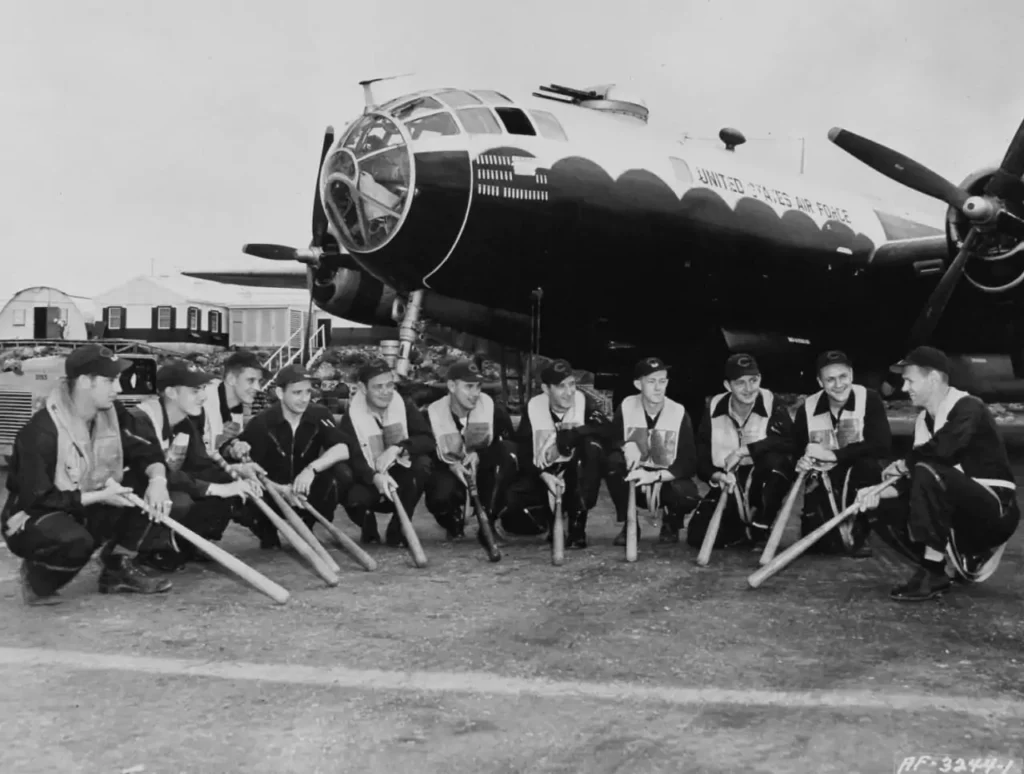
- December 2-7
Bomber Command boosted its radar-directed bombing support for IX Corps during the fight for Sniper Ridge, north of Kumhwa, by tripling the number of B-29s assigned to the mission. - December 29/30
The 307th Bomb Wing dispatched 11 B-29s to bomb the Teagam-ni headquarters area, resulting in the destruction of 146 structures. - December 30/31
B-29 lost: The 19th Bomb Group conducted a bombing run on the Choak-tong ore processing plant located near the Yalu River. With the aid of a full moon and a signaling aircraft, enemy interceptors managed to shoot down one B-29 and severely damage two others, forcing them to make an emergency landing at Suwon Air Base. The B-29 that was shot down was identified as 44-62011 from the 28th Bomb Squadron of the 19th Bomb Group. It was brought down by Soviet Air Force MiG-15 pilots and is believed to have crashed about 40 kilometers north of Pyongyang. Seven crew members lost their lives, while five others were taken as prisoners of war.
January 1953
B-29 attacks during nighttime in North Korea were no longer safe as enemy night interceptors brought down four B-29s in January. The enemy utilized ground radar to direct their interceptors, while moonlight, contrails, searchlights, and flares helped identify the B-29s visually. Coordination between the interceptors was carried out by controller aircraft.
To counteract these tactics, the B-29s flew in a condensed formation and employed chaff and electronic jamming to disrupt radar-controlled searchlights. Additionally, Bomber Command requested that fighter interceptors provide overhead coverage for the B-29s in the target area.
Also, the 581st ARCW assigned four B-29s and aircrews to the 91st Strategic Reconnaissance Squadron to drop leaflets over North Korea.
- January 4/5
Twelve B-29 bombers from the 307th Bomb Wing attacked the supply areas and railway bridge in Huichon. - January 9/10
Seventeen B-29s initiated an attack campaign on the Sinanju communication complex by targeting rail bridges at Yongmi-dong, anti-aircraft gun positions near Sinanju, and two marshaling yards located at Yongmi-dong and Maejung-dong. - January 10
- B-29 lost: The B-29 44-61802 from the 307th Bomb Wing’s 372nd Bomb Squadron was struck by enemy fire from MiG-15s while conducting a bombing run over the Anju Marshaling Yard. The crew was forced to evacuate the aircraft.
- January 10/11
The 307th Bomb Wing’s B-29s conducted bombing raids on the marshaling yards of Sonchon and Anju. One of the B-29s, betrayed by its contrails, was illuminated by enemy searchlights and ultimately shot down by enemy fighters. - January 13
B-29 lost: An RB-29, 44-62217 from the 581st Air Resupply and Communications Wing (AR&CW), was shot down by a dozen enemy fighters while on a mission to drop psychological warfare leaflets over North Korea. The crew consisted of Col. John K. Arnold Jr., Commander of the 581st ARCW, with three fatalities and eleven crew members being captured and later released. The Mig-15 that brought down the RB-29 was piloted by Senior Lt. Khablev. - January 17/18
The 98th Bomb Wing launched an attack on the Pyongyang radio station, which was located 42 feet below ground and in close proximity to a potential prisoner-of-war camp. Despite the efforts of 11 B-29s and the use of 2,000-pound general-purpose bombs, the radio station was not effectively destroyed as the bombs only managed to score 8 to 10 hits but did not penetrate deeply enough. - January 22
The capture of Colonel Arnold and his crew members was announced by the Peking radio. Out of the crew, three lost their lives when the B-29 crashed on January 13th. The communist authorities did not set Colonel Arnold free until 1956. - January 27
B-29 lost: The 307th Bomb Wing’s 44-27262 aircraft crashed near Tom-Ni in North Korea after being attacked by Major Anatoly Karelin, a pilot from the Soviet Air Force, flying a MiG-15 fighter. Ten crew members were able to evacuate the plane before it crashed, with one of them being rescued and three losing their lives in the crash. - January 28/29
B-29 lost: The B-29 “Double or Nothin'”, 42-65357 and part of the 19th Bomb Group 28th Bomb Squadron, was brought down over the target southwest of Sariwon. It appears that enemy fighters spotted the aircraft against the bright moonlight and shot it down, marking the fourth loss of a B-29 since December, but the final one of the war.
The aircraft was originally designated as the “Shady Lady” of the 98th Bomb Wing but was damaged in June 1951, sent back to the United States for repair, and then returned to the 19th Bomb Group.
USMC Skyknight aircraft that was escorting the B-29s used innovative tactics to take down a night interceptor, marking the first time that a radar-equipped jet fighter could destroy an enemy jet at night. - January 29/30
Another B-29 was severely damaged by enemy fighters, just as in the previous night’s incident. - January 30/31
A B-29 from the 307th Bomb Wing was severely damaged by around ten enemy fighters and only just managed to make an emergency landing in South Korea.
February 1953
In order to make the B-29 attacks as unpredictable as possible, Bomber Command planned missions to occur during the dark phase of the moon, targeting heavily defended areas. To thwart enemy radar and searchlights, the aircrews flew at different altitudes, avoided altitudes that caused contrails, and utilized ECM (Electronic Countermeasures) effectively. The use of a compressed bomber stream allowed for a higher concentration of chaff and electronic jamming in the target area, offering mutual protection for the bombers.

A detachment at Itazuke Air Base in Japan, consisting of personnel from the 19th Bomb Group and 307th Bomb Wing, was established to serve as a backup landing site for B-29s that were unable to return to their primary bases at Yokota in Japan or Kadena in Okinawa following a combat mission.
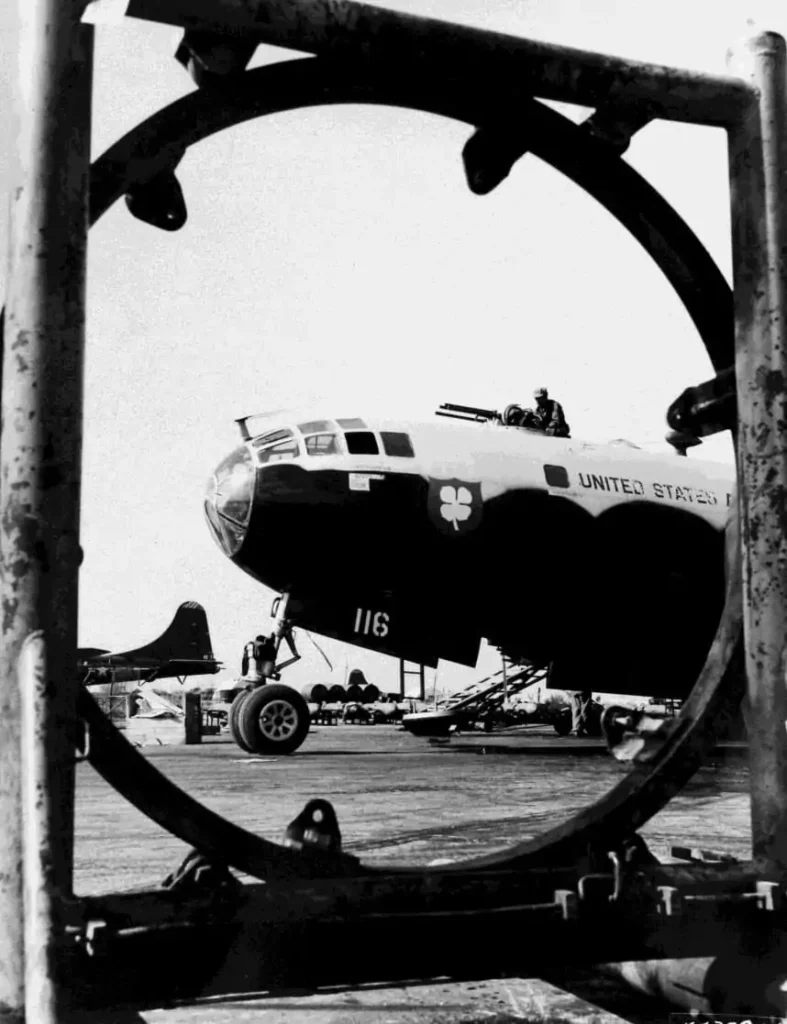
- February 15/16
The communication center at Pingjang-ni was targeted by B-29s, resulting in damage to power lines and causing Radio Pyongyang to go offline.
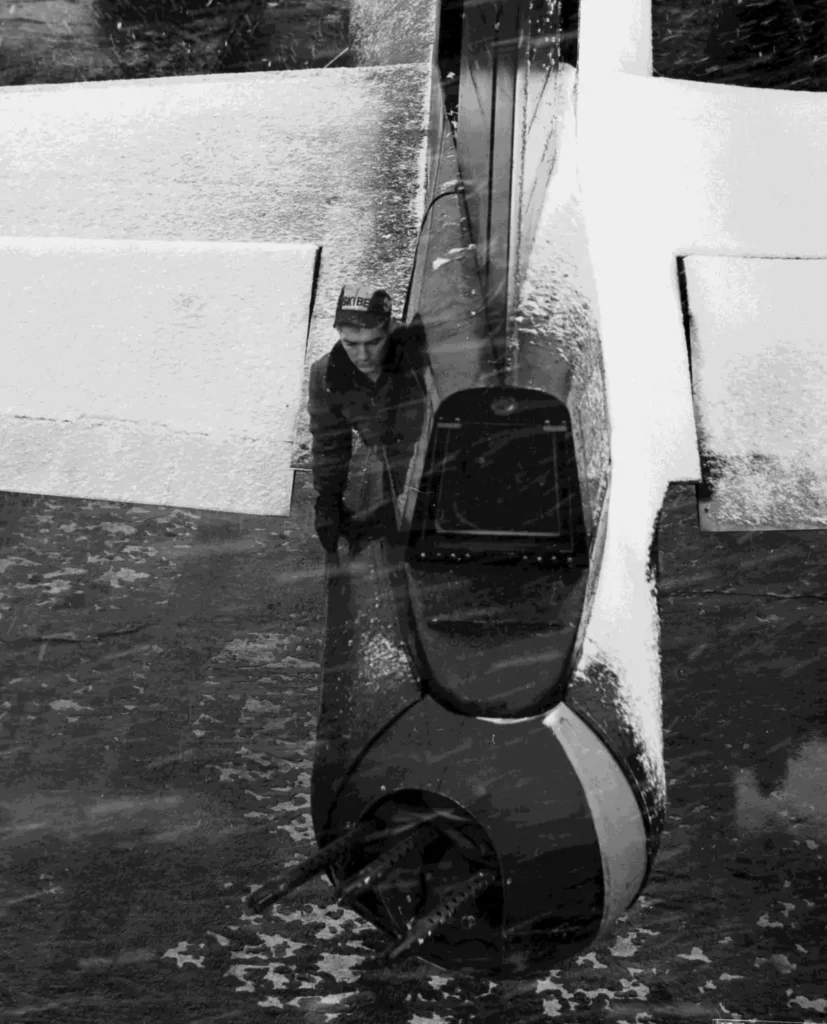
March 1953
As part of the Spring Thaw operation, B-29s ventured deep into North Korea. Despite the increasing enemy air strength, including more jet light bombers, more early-warning and ground-controlled intercept units, and a new ground-controlled approach system, Bomber Command intended to continue bombing raids in MiG Alley throughout the war.
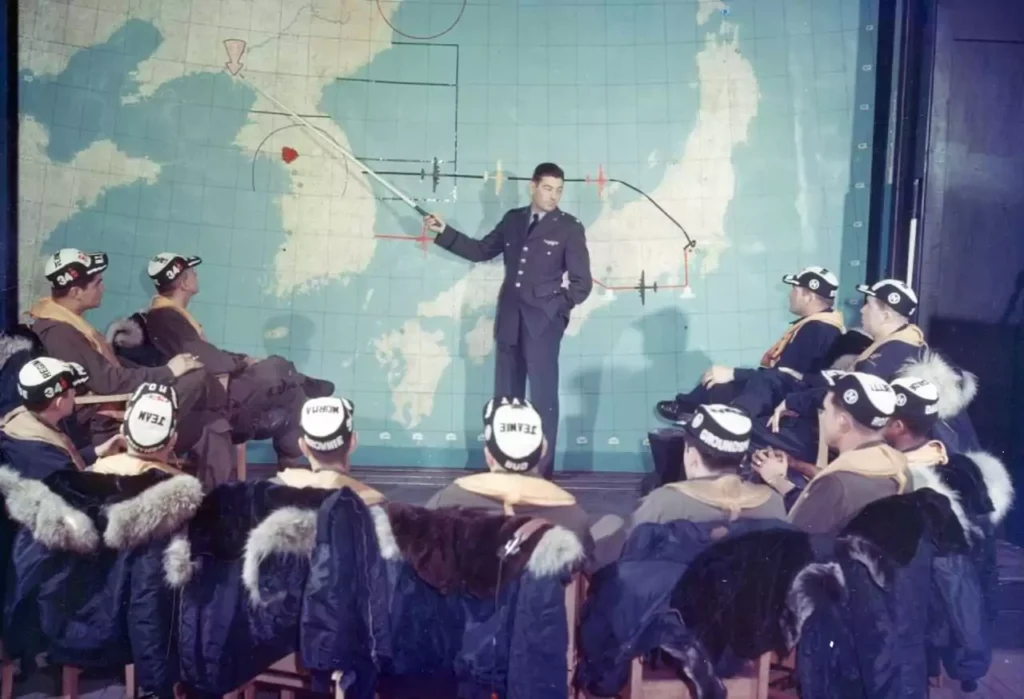
- March 5/6
Seventeen B-29s from the 98th Bomb Wing targeted a key supply center in North Korea at Onjong, while two B-29s from the 19th Bomb Group conducted close support operations near the U.S. IX and X Corps. Additionally, two more B-29s used SHORAN to strike the Naewan-ni marshaling yard on the eastern coast. - March 13/14
Twelve B-29s from the 307th Bomb Wing conducted a deep-penetration raid on a cantonment near the Choak-tong ore-processing plant, located close to the Yalu River. - March 22/23
Eight B-29s from the 19th Bomb Group continued to attack the bridges at Yongmidong. The raiders noticed that one of the bridges, damaged the previous night, had been repaired. Despite evidence of congested traffic near the bridges, FEAF Bomber Command chose to halt further raids, as they feared that repeated attacks could result in significant losses for the returning bombers.
April 1953
As spring approached, the level of ground activity decreased to limited attacks and probes. The B-29 bombers of the Bomber Command and fighter bombers from the Fifth Air Force worked together to target railroad centers, aiming to disrupt the supply route from Manchuria to the enemy’s front lines. In April, the focus shifted to attacking enemy troop concentrations and supply areas. Although the number of MiG-15 aircraft sightings remained low, with only 1,622 reported, the enemy deployed an unusually high number of between 400 and 500 fighters to two airfields near the Yalu River, which were within clear view of UN counter-air patrols. This large deployment was interpreted by intelligence officers of the FEAF as a show of defensive strength.
To gain access to the latest communist jet aircraft, the FEAF launched Project Moola, offering political asylum, resettlement in a non-communist country, anonymity, and a $50,000 reward to anyone who delivered a MiG or any other jet aircraft to the UN forces in Korea. An additional $50,000 was promised to the first person who took advantage of this offer. In September 1953, after the ceasefire, a North Korean MiG-15 pilot defected and safely landed his aircraft at Kimpo AB in South Korea.

- April 1
A B-29 from the 307th Bomb Wing, unable to hit its designated target, visually bombed a convoy of trucks and reported excellent results. This attack was thought to be the first of its kind since the initiation of operations in North Korea by Bomber Command. - April 6/7, 7/8, 11/12
During the night, B-29s from Bomber Command conducted an attack on the three functioning railroad bridges across the Chongchon River in Sinanju. The next day, fighter bombers targeted the congested traffic on the roads leading to the damaged bridges. - April 26/27
A B-29 bomber initiated Project Moola, the Fifth Air Force effort to obtain a MiG-15, by dropping leaflets over North Korea.
May 1953
FEAF Bomber Command primarily targeted supply storage areas and troop concentrations. The Kuwonga Dam was considered a critical target and was struck twice by B-29s.
- May 10/11
Thirty-nine B-29 Superfortresses attacked the 375-acre Yangsi military concentration site located 12 miles southeast of Sinuiju City, causing 63% destruction to one of the final significant targets still present in North Korea. - May 18/19
Eighteen B-29 Superfortresses continued the attack on the Yangsi troop concentration area with the aim of completing its destruction. - May 19/20
Eighteen B-29s from the 19th Bomb Group conducted a bombing run on a massive supply depot in Unsan-dong, resulting in the destruction of 140 structures. The complex, located 8 miles west of Sinanju, was believed to house coastal defense forces and serve as a temporary base for troops in transit. - May 21/22
B-29s utilizing SHORAN technology successfully targeted the Kuwonga Dam with seven direct hits, however, the dam did not break due to the North Koreans lowering the water level by twelve feet, which reduced the pressure on the dam. - May 28/29
The B-29s went back to attack the Kuwonga Dam and managed to make five direct hits with 2,000-pound bombs. Though the dam did not break, the North Koreans were forced to completely drain the reservoir to fix the damage, causing a shortage in the water supply for agriculture.
June 1953
The FEAF coordinated bombing raids on airfields using both B-29 bombers and fighter bombers, targeting even nearby dams in an attempt to flood the runways and render them unusable.
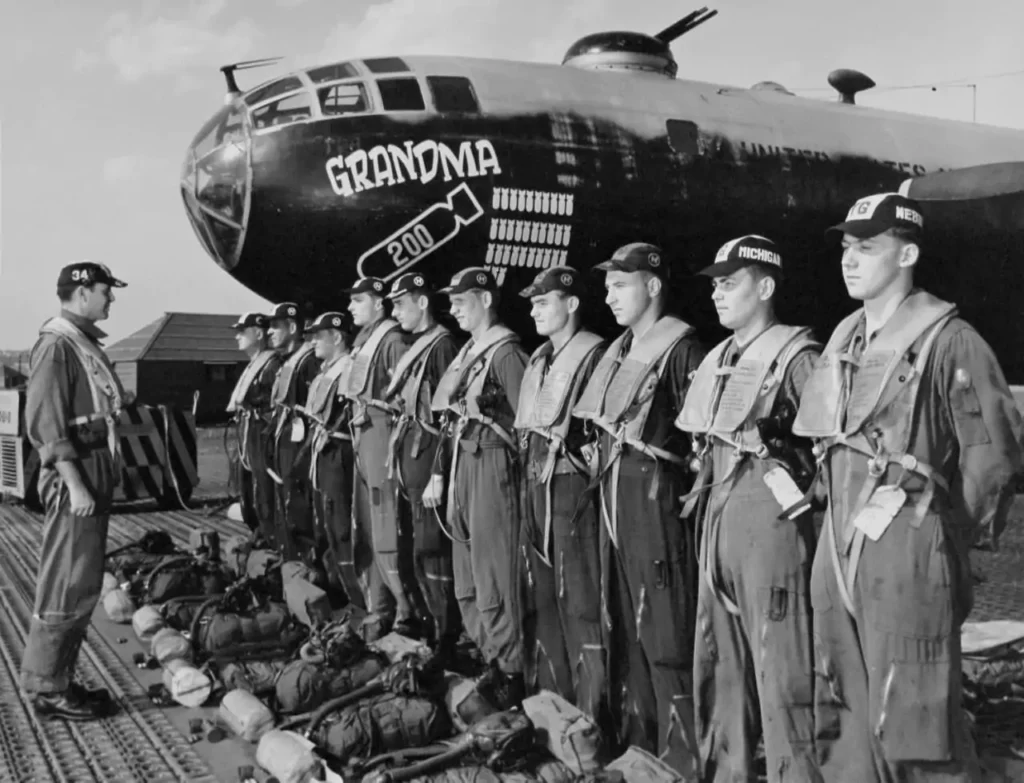
- June 1
The 19th Bomb Wing underwent a transition, relocating on paper from Andersen Air Force Base in Guam to Kadena Air Base in Okinawa. In this process, the 19th Bomb Wing absorbed personnel and equipment from the 19th Bomb Group and gained control over tactical operations. - June 2-3
The Bomber Command B-29s initiated night-time close support missions, primarily targeting areas where the communist forces were gathering troops and supplies for training in the western sector of the U.S. IX Corps region. - June 10
Coordinated attacks on North Korean airfields were carried out by the Fifth Air Force and Bomber Command. Sixteen B-29 bombers from the 98th Bomb Wing targeted Sinuiju and Uiju, encountering anti-aircraft fire and enemy fighters. Fortunately, no losses were reported. - June 13-18
Combined efforts from Fifth Air Force, Bomber Command, and the USMC were made to disrupt airfield operations in Namsi and Taechon by bombing the irrigation dams at Toksan and Kusong. Despite their efforts, the raids were unsuccessful in breaking the dams, as the North Koreans had already lowered the water levels to reduce the pressure on the structures.
July 1953
- July 4/5
Twenty-four B-29 bombers from the Bomber Command targeted airfields at Taechon, Namsi, and the main airfield in Pyongyang. - July 7
- The 19th Bomb Wing sent B-29 bombers to strike Namsi Airfield in North Korea.
- B-29 lost: The B-29 named Star Duster, with the serial number 44-69818 and belonging to the 28th Bomb Squadron of the 19th Bomb Wing, met a fatal end after crashing at airfield K-3 in Pohang. The aircraft was flying low on fuel and attempted to land at the recovery airfield in unfavorable weather conditions, resulting in the loss of all 13 crew members.
- July 7/8
A formation of sixteen B-29 bombers attacked a supply center and a rail yard at Namsi. - July 10
Seven B-29s from the 19th Bomb Wing targeted Namsi Airfield and dropped 110 tons of bombs. Meanwhile, four B-29s from the 307th Bomb Wing targeted frontline positions.

- July 10/11
The 98th Bomb Wing’s B-29 bombers targeted the bridges at Sinanju, while the 307th Bomb Wing’s B-29s struck the rail bridges located at Yongmi-dong. - July 13-19
Nearly 100 missions were flown by B-29 medium bombers in support of the ground forces, delivering 4,000-pound air-burst and delayed-action antipersonnel bombs to counter the communist offensive. - July 21/22
Eighteen B-29 bombers from FEAF Bomber Command brought the war to a close with a strike on the Uiju Airfield. - July 22
The 19th Bomb Wing conducted a bombing run, dropping 20 4,000-pound bombs on Chinese military positions and artillery positions located near Kumhwa. - July 25
98th Bomb Wing’s last bombing mission of the Korean Conflict. - July 27
Last day of the Korean Conflict—two RB-29s of 91 SRS dropped propaganda leaflets on North Korea.
Flying a 91st Strategic Reconnaissance Squadron RB-29, Lt. Denver S. Cook piloted the last FEAF Bomber Command sortie, dropping
leaflets over North Korea.
Further reading
- Boeing B-29 Superfortress Facts: 11 things to know
- Boeing B-29 Superfortress Units of the Korean War (1950-1953)
- Known B-29 Superfortress Losses in Korea (1950-1953)
- USAF Korean Air Bases (K-Sites) codes, 1950-1953
Bibliography
- B-29 Superfortress Units of the Korean War by Robert F. Dorr
- The Last War of the Superfortresses: MiG-15 vs B-29 over Korea by Leonid Krylov and Yuriy Tepsurkaev
- The USAF in Korea A Chronology 1950-1953 by the Air Force Historical Research Agency.
- MiG Alley: The US Air Force in Korea, 1950–53 by Thomas McKelvey Cleaver
- The United States Air Force In Korea 1950-1953 by Robert F. Futrell
- The Korean War An Exhaustive Chronology by Bud Hannings
- Korean Air War: Sabres, MiGs and Meteors, 1950–53 by Michael Napier